

Small Craft Advisor
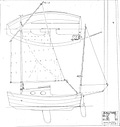
Boat Designs: Evaluating SCAMP’S Big Sister
(this new welsford cruiser checks a lot of boxes…).
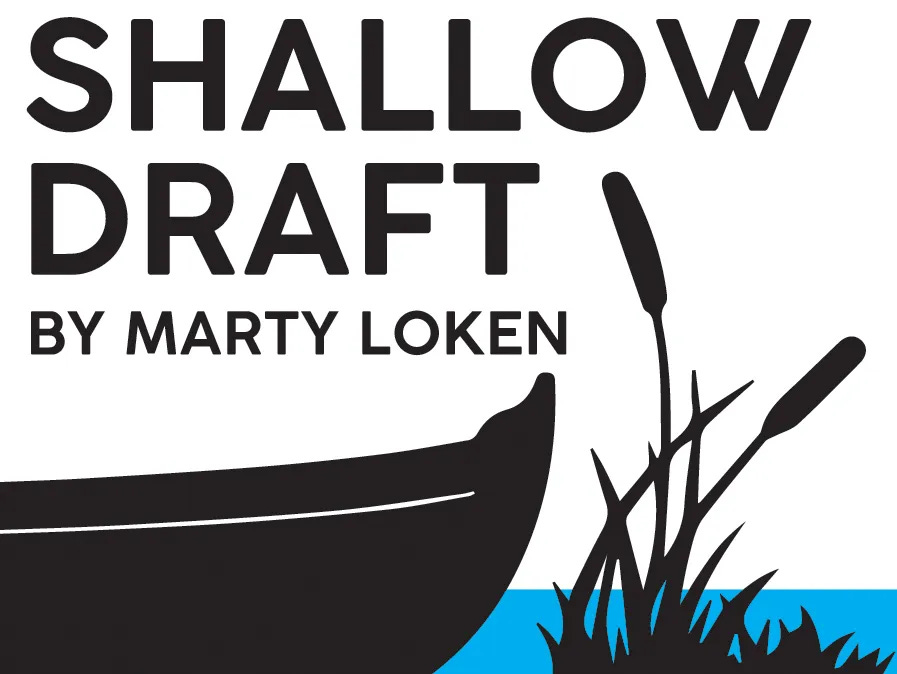
Over the past few days I’ve had email exchanges with John Welsford, New Zealand designer, regarding a brainstorm that’s been percolating in his clever, whimsical noggin: A bigger, more commodious takeoff on his wildly popular SCAMP design.
As most SCA readers know, the 11’ 11” SCAMP design was conceived 13 years ago when Josh Colvin, editor of this fine publication, asked Welsford to come up with a new kind of small cruising boat—one small enough to explore the most hard-to-penetrate backwaters, while being easy to rig, light enough to trailer with the smallest of tow vehicles, surprisingly great under sail, and comfy for overnight camp-cruising adventures. So, following some tweaks by designer and master boatbuilder Kees Prins, the resulting sailboat was dubbed SCAMP, for Small Craft Advisor Magazine Project.
SCAMP DRAWING…
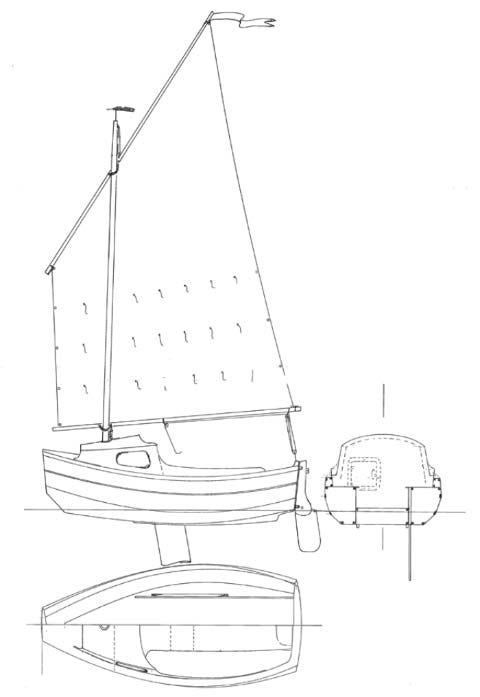
The rest is history: More building plans and kits for SCAMP have been sold over the years than any other small cruising boat we can think of. Besides the original wooden version, Gig Harbor Boat Works was licensed in 2013 to produce a fiberglass SCAMP, and the little giant killer—in wood and fiberglass—has since its debut been at the center of various small-boat rallies, workshops and sailing events.
While SCAMPs are still being built worldwide by enthusiasts, plan and kit sales have slowly been approaching what might be a kind of saturation point. It’s not that “everyone who wants a SCAMP has already built one,” but we get the feeling that it’s time for something new and different—like a SCAMP-inspired design that has the personality and quirky appeal of the original boat, but with more creature comforts (for an aging population of SCAMP lovers).
Meet SCALLYWAG, John Welsford’s big sister to SCAMP, a 15’ 4” x 7’ 3” wonder with a “real” cabin, tabernacle mast, mizzen sail, powerful main, water-ballast tanks, sitting headroom down below…and like SCAMP, faster than many onlookers might expect.
SCALLYWAG DRAWING…

This might turn out to be a timely, common-sense follow-up to the successful SCAMP design—so tempting that John Welsford is talking about building one for himself.
(As a footnote, we might add that in 2008, prior to the introduction of SCAMP in 2010, Welsford came up with another design that was similar to but somewhat larger than SCAMP—called TREAD LIGHTLY, which measured 13’ overall, with a beam of 5’ and addition of a mizzen. The series of similar hulls began with PEANUTS, an experimental build that never quite made the plans list. That design led to TENDER BEHIND, then SHERPA, then TREAD LIGHTLY, then SCAMP, then SCRAPS and now SCALLYWAG. Quite a series!)
TREAD LIGHTLY drawing…immediate predecessor to SCAMP)
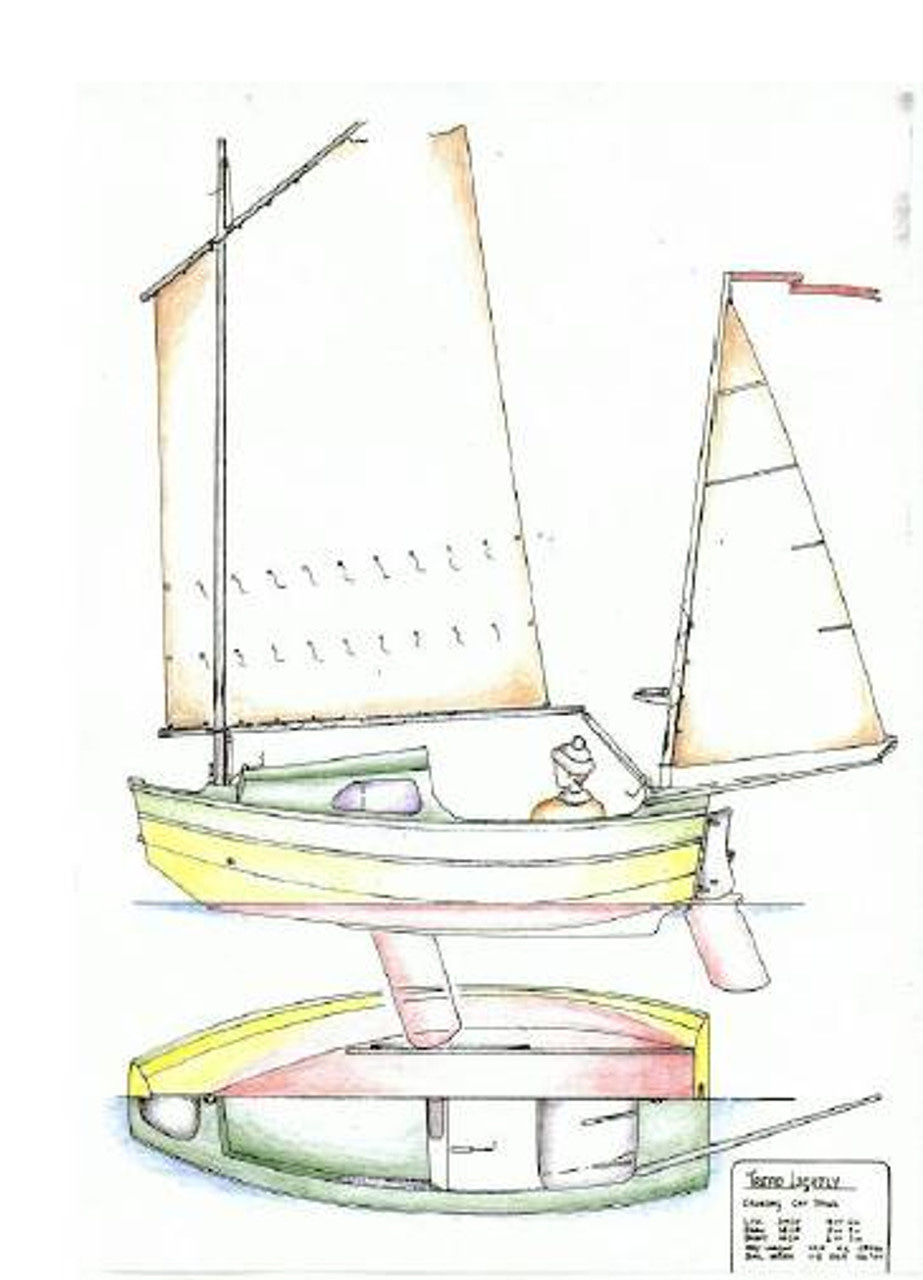
Here is John Welsford’s description of the SCALLYWAG design:
“I’ve had a number of people tell me they love SCAMP, but they’d like a ‘real’ cabin—something that would provide shelter for a couple of friends to overnight out of the rain; somewhere with space enough for four to sit and chat over coffee or rum on a cold evening; somewhere with a bench for a cooker, a table to eat the food off of, and lockers for all the essentials…and room for the skipper and first mate to stretch out and sleep in comfort.
“SCALLYWAG is not so big as to make launching and retrieving a chore; her mainmast is in a tabernacle, which makes standing it up easy-peasy for clients who don’t like the idea of lifting a mast that size vertically into place. Her mizzen is light enough to not be a worry, too, in that respect.
“The rig is a powerful one, but easy to access for reefing, and she will heave to under mizzen with the main let free so she sits mostly head-to-wind, dry and restful if a gust has to be waited out.
“I’ve added a pair of big water tanks for ballast, so with that and her beamy shape she’ll be very stable. Her cockpit self-drains, the motor is inside the tall transom for easy access, and while there’s room in the cockpit for four, she’ll be easy to single-hand and relaxing to sail.
“While the relationship between SCALLYWAG and SCAMP is obvious, it’s not just the styling. The backroom calculations in hydrodynamics suggest she’ll handle well, and be faster than many expect. With high stability and the ability to sit upright when aground, she’ll be able to transition from hiding in the mud or sand up a creek somewhere, to making a longer coastal passage without any fuss.
“Construction is simply plywood over ply bulkheads, with stringers to line everything up, and with considerable buoyancy just in case. The plans will have scale drawings of all major components, and we anticipate soon having printable full-sized templates for frames and other key items.”
As for specifications, beyond the overall length of 15’ 4” and beam of 7’ 3,” SCALLYWAG will have board-up draft of 10,” a board-down draft of 3’ 4,” a total sail area of 143 s.f. and a fully-rigged dry weight of 750 lbs. (Incidentally, the beam-to-length ratios of SCAMP and SCALLYWAG are almost identical.)
John Welsford says that plans for SCALLYWAG will be available on December 1, but he can take orders in the meantime. Price will be $245 U.S. funds for emailed, printable PDFs, and the plans can be ordered via John’s website: jwboatdesigns.co.nz (Joel Bergen, well-known for the Welsford Navigator he built and sails in many Northwest small-boat events, will be developing a set of SCALLYWAG patterns in the not-distant future, according to Welsford. Editor’s note: We heard from Joel yesterday; he’s hoping to develop CAD-produced patterns “in a few weeks,” now that he’s received initial SCALLYWAG drawings. Stay tuned; we’ll provide updates on plans and patterns in this space.)
FIRST IMPRESSIONS OF THE SCALLYWAG DESIGN:
Eager to hear what SCAMP-savvy friends might have to say about the SCALLYWAG specs and just-released drawing, we sought initial reactions from…
JOSH COLVIN, editor of Small Craft Advisor , who commissioned the SCAMP design in 2010 and enjoys sailing SCAMP #1:
“There’s certainly no doubt who designed this one! It looks almost as much like Welsford’s PENGUIN as a SCAMP. SCALLYWAG’s length is a sweet spot in terms of accommodations potential. She’ll be rowed less than most SCAMPs, but I love the inboard motor well to keep her lines clean, and the engine right at hand. But her most exciting feature is the addition of the mizzen, which will improve seaworthiness and make managing the mainsail easier.
“Between LONG STEPS and SCALLYWAG, those looking for something like SCAMP, but larger, have great options. I’m excited to see the first boat built—she will be bigger than most expect, just looking at the drawing.” SIMEON BALDWIN, builder of an early SCAMP who has perhaps sailed more nautical miles with a SCAMP than anyone…and who has also served as a generous advisor to fellow SCAMP builders and is an expert on rigging and sailing the little 11’ 11” boats:
“I like what I see of this long-rumored design. Knowing John and his attention to ergonomics, I can anticipate it will work well. The tabernacled mast and addition of a mizzen are most appealing.
“From the drawing I think it may resemble LONG STEPS in terms of the recessed footwell. It also appears he is eschewing a by-design lazarette made popular by many SCAMP owners.
“The double water tanks are something to contemplate. I don’t envision SCALLYWAG as a purpose-built racer with crew, actively keeping high-side ballast on long tacks, like the SKATE 15 that Brandon Davis designed, which utilizes two tanks and a dump-valve system that may be more elaborate than a typical cruising sailor would want to live with. But John may be describing two water tanks that are filled and remain separate from one another.”
(Editor’s note: Welsford’s comment on tanks, “The ballast tanks are linked, and they’re not far enough off the centerline to work independently. There is one each side of the aft end of the centerboard case and they go out as far as the seat-front extensions.”)
“I’m looking forward to how all of this works out!”
BRANDON DAVIS, of Turn Point Design in Port Townsend, whose company cuts CNC kits for the SCAMP and a variety of other small boats. Brandon is also a skilled designer and small-boat sailor:
“I really like this boat, since it has just enough room to have a cabin but it’s still small enough to be trailered, beached and easily built in a garage. The enclosed cabin should encourage longer trips or taking a friend along.
“The longer waterline should increase average sailing speeds. My guess is that rowing speed will be lower than the SCAMP, as the rower will not be able to take advantage of the waterline length because of her weight.
“Will SCALLYWAG be offered as a kit? I could see it selling well as a kit and the market could be ripe. Many SCAMP builders might consider this as their next build.
“I look forward to seeing the first SCALLYWAGs on the water!”
KEES PRINS, designer and boatbuilder, who constructed the first SCAMP while serving as boatshop manager at the Northwest Maritime Center…and in the process suggested and implemented some changes that improved the design:
“I think SCALLYWAG will find a great following in the SCAMP world and beyond. Adding a cabin will greatly enlarge the ‘SCAMP Crowd.’ At that beam, and with twin ballast tanks, stability should be enormous for a boat this length. I would have liked to see a cross section through the cabin to know more about sitting comfort. (Four people hanging out inside seems a little optimistic, but two should be comfortable.)
“I’m curious about what the tabernacle for the unsupported mast will look like. A big sail area, together with a stiff hull will induce a significant load on the tabernacle. There seems to be a deep well for the mast base to swing through, judging by the drain hole.
“All in all, SCALLYWAG looks very promising.”
OSCAR LIND, a serious student of all various small-boat designs , and earlier builder of a SCAMP, who shares at least one thing in common with John Welsford—they’ve never met a pun they didn’t like:
“I might have to clear out the shop and make as much room as possible to build this boat (due to the 7’ 3” beam, especially). It’s so tempting and fills the bill for usability and function.
“It does need a Chinese lug rig, though. I expect quite a few SCALLYWAGS will ultimately be built.”
(Editor’s note: John Welsford comments, “I like the Chinese lugsail, but for a sail of this size on a boat that will be trailered, rigged and derigged for each outing and dry-stored, the extra complexity of the Junk sail slows the process. As well, the balanced lug is in my experience, a little quicker upwind—unless the junk rig has cambered-panel sails, and there are few sailmakers producing those, so I think in this case, simplicity and performance get the nod.”)
As for my personal view as a serial boatbuilder, restorer and sometimes buyer of project boats, I enjoyed owning a SCAMP several years ago. While I loved sailing the boat, I wished it was bigger and included a sleeping cabin. So, John’s new SCALLYWAG design checks many more boxes as an all-around keeper, and I prefer its overall hull, cabin and rig design, not to mention its potential as a serious cruising machine.
So, once again, here’s a chance for you, as a fellow boat nut, to offer your evaluation of SCAMP and her newly-hatched big sister, SCALLYWAG. (Also, please add other thoughts in the comments section below…) • SCA •
Ready for more?

- My Boats & Boat Articles
- Many types of Boatbuilding Plans
- Free Stitch and Glue Boat Plans
- Characteristics of Carbon Fiber
Steps in Building SCAMP
Here are the various steps I took to build my John Welsford SCAMP from Plans. The steps are not all in perfect chronological order because I would stop and work on a different part, then go back to what I was doing.
I build without assistance and some of my decisions and methods might not be the best or fastest. They work though. Because I work alone I have to find some ways of doing things that might take longer but can be safely accomplished by one person. I got help turning the boat though. The instruction manual is quite vague on many points and I hope future builders will find this boat building record useful.
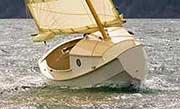
I try to be accurate and check my information, but mistakes happen.
- Skerry build
- Stitch & Glue Boatbuilding
- Free Boat Plans

Small Print
This information is for general knowledge and entertainment. It's not intended to replace plans or proper instructions. I'm not suggesting that was I did was the best way.
SCA (Small Craft Advisor) Editors on SCAMP
"What does a man need-really need? A few pounds of food each day, heat and shelter, six feet to lie down in-and some form of working activity that will yield a sense of accomplishment. That's all-in the material sense, and we know it. But we are brainwashed by our economic system until we end up in a tomb beneath a pyramid of time payments, mortgages, preposterous gadgetry, playthings that divert our attention for the sheer idiocy of the charade. The years thunder by, the dreams of youth grow dim where they lie caked in dust on the shelves of patience. Before we know it, the tomb is sealed. Where, then, lies the answer? In choice. Which shall it be: bankruptcy of purse or bankruptcy of life?" -Sterling Hayden
Our own youthful dreams often featured small boats in supporting roles. Stalwart little vessels aboard which we'd venture across nebulous bodies of water in search of uncharted shores and uninhabited islands. Sometimes we'd land and go ashore to explore or make camp, often retreating to our boats to wait out a summer storm beneath a boom tent. We'd read sea stories by oil lantern and, on clear nights, sleep under a blanket of stars.
Curiously, these fanciful voyages never involved wrestling with a heavy mast, fussing with a smelly outboard, or being held off shore by our boat's draft. And even when we pictured whitecaps kicked up by a stout afternoon breeze, never was there a chilly capsize.
It was a longing for those simple pleasures that inspired thoughts of SCAMP. That and a persistent desire to go over "there"-that place we often see but can never quite reach. It seems to happen on every cruise. Never mind that we're usually sailing the smallest boat around for miles. We always come upon some ultra-shallow bay or intriguing tidal stream that disappears into the reeds, trees and rushes. To get in there-all the way in there-a boat needs to be light, shallow and easily propelled-and preferably flat-bottomed should we decide to stay though the ebb.
Trying our best to distill small-boat cruising to its essence, we sorted out our ideas and took the best of them to one of our favorite designers-John Welsford. It shouldn't have surprised us that, being of a like mind, he responded enthusiastically.
What we commissioned was the most micro of cruisers. We wanted a cabin, not for a claustrophobic casket-like berth-but for dry stowage, buoyancy and a bulwark against wind and seas. We tried to be honest about the compromises. In describing the boat to John we said SCAMP would be so small that, "the designer himself might cringe a little when he puts the pencil down."
Remarkably, where we expected John would need eleven or even twelve feet to meet our goals, he was able to do so in slightly over ten. And where we'd resigned ourselves to the possibility she might be at least slightly less capable than larger microcruisers, John drew SCAMP with a selfdraining cockpit, abundant flotation, and 145-pounds of water ballast. Unlike many larger designs, SCAMP should be recoverable from a complete capsize.
We've long been fans of pram bows and how they maximize volume at a given hull length, and before we could ask, John's initial reply suggested one for SCAMP
Thanks to an offset centerboard the cockpit sole/ single berth measures 25 x 77 inches, making accommodations almost luxurious for the solo sailor. Designed to be sailed, rowed and perhaps sculled, SCAMP can also be fitted with an outboard in place of her rudder-or with an optional mount for a trolling motor.
We believe every boat needs a bucket, so we asked John if he could design in a designated spot for one. He did. Every SCAMP sailor will have at hand a storage container, fire extinguisher, drogue or emergency steering aid, rudimentary head, bailing device, and a tool for filling the ballast tanks.
We wanted the simplicity of a single sail (single halyard, single sheet, etc.) and John wisely recommended the balanced lug. Although we're fans of this rig and unanimously saw it as the best choice, we wondered if some potential builders might prefer the more familiar gaff sail. At our urging, and with some reluctance, John drew SCAMP with a gaff. The resultant drawing with the much higher aspect rig looked less purposeful, unwieldy-almost fragile. Seeing SCAMP dressed like this so convinced us of the balanced lug's better suitability that we scrapped the gaff option altogether. John appreciated our coming to our senses and wrote, "The lugsail gets the right amount of area in the space available without getting outside the ends of the boat or going up too high. Remember that this is a very stable boat, and can carry a lot of sail without risk, and that's one of the strengths of the lugsail."
John suggests a practiced amateur could have the construction done and ready for paint in about 110 hours. It's our hope that new sailors and first-time builders will appreciate the small size and simplicity of the design, and that more experienced builders and sailors will appreciate SCAMP's surprising level of sophistication.
Although SCAMP wasn't designed specifically with kids in mind, we think she would make an ideal exploration boat for young sailors-safe, capable and easily handled. We intend to donate a set of plans to any formal organization or school looking to build a SCAMP for this purpose.
Now on to the next step-finding a builder for the prototype and getting SCAMP in the water! SCA
SCAMP Plans are available at Duckworks


SmallCraftAdvisor.com
Small-Boat Related Message Board
Skip to content
- Subscriptions
- Back Issues
- Instant Downloads
- Boat Plans & Kits
- Message Board
- Classifieds
- Quick links
- Home Board index SCAMP
- It is currently Tue Mar 05, 2024 6:33 pm
- All times are UTC
Scamp performance vs Potter p15
Moderator: Moderator
Post by tony lang » Sun Sep 03, 2017 1:00 am
Re: Scamp performance vs Potter p15
Post by Friends with SCAMPS » Sun Sep 03, 2017 3:28 am
Post by Brent65 » Sun Sep 03, 2017 9:42 pm
Post by wdscobie » Mon Sep 04, 2017 2:22 am
Post by Bchrovers » Wed Sep 06, 2017 3:54 am
Post by pocketyacht » Thu Sep 07, 2017 12:30 pm
Post by tony lang » Sat Sep 16, 2017 6:15 am
Post by Bchrovers » Sat Sep 16, 2017 11:35 am
Post by tony lang » Sun Nov 12, 2017 6:14 am
Post by tony lang » Sun Feb 18, 2018 4:45 am
Return to “SCAMP”
- Boat Building and Designs
- Small Boat Events and Gatherings
- Race to Alaska (R2AK)
- West Wight Potter
- Precision Sailboats
- ↳ News and Annoucements
- ↳ General Discussion
- Home Board index
Powered by phpBB ® Forum Software © phpBB Limited
Style by Arty - phpBB 3.3 by MrGaby
Privacy | Terms

- Plans & Kits
- Kits and Packages
- Qty in Cart

Scamp Foils Kit

SCAMP CNC PLYWOOD KIT
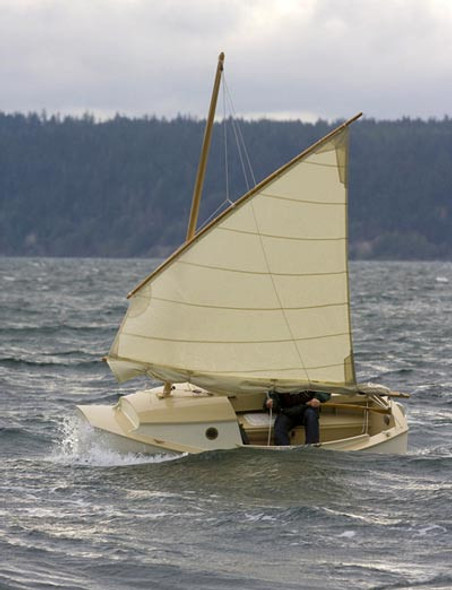
S.C.A.M.P. Plans Instant Download

Scamp Hardware

SCAMP Rigging Kits

Rudder Hardware for Scamp

S.C.A.M.P. Printed Plans

S.C.A.M.P. Sail
- Total: items /
- Add all to cart
Adding your products to cart
The story of my SCAMP sailboat build. For more information on the design, see www.smallcraftadvisor.com
Sunday, June 7, 2015
Launching day scamp #243 is afloat.

Sunday, March 29, 2015
Applying sail numbers - what worked, what didn't....

Sunday, March 22, 2015
Diy no-cost hiking stick clip.

Sunday, March 15, 2015
Mast support blocks cut and fit.

SCAMP gets a nose job (solving a problem with a custom router jig)

Sunday, March 1, 2015
Mast and spars - final sanding and shaping.

Sunday, February 22, 2015
Birdsmouth mast glued up.

Boat Profile
A little camp cruiser for big dreams
From Issue Small Boats Annual 2016 October 2015
N ever mind that until grounding on a mudflat less than 30 miles from the finish line, SCAMP #4 breezed through a difficult year in the 300-mile Everglades Challenge adventure race a few years ago, pressing on comfortably when many bigger boats had to quit. Never mind that during the inaugural Race to Alaska earlier this year, SCAMP #11 completed a very rough 40-mile open-water crossing of the Strait of Juan de Fuca, taking its solo skipper safely from Port Townsend, Washington, to Victoria, British Columbia. And never mind that yet another SCAMP (extensively modified for the venture by its builder) may attempt to round Cape Horn—yes, that Cape Horn—this year and, if successful, will be the smallest sailboat ever to do so. Despite all that, the overwhelming impression I get when Dave Ender drives up with his newly built SCAMP to take me sailing is: What a cute little boat.
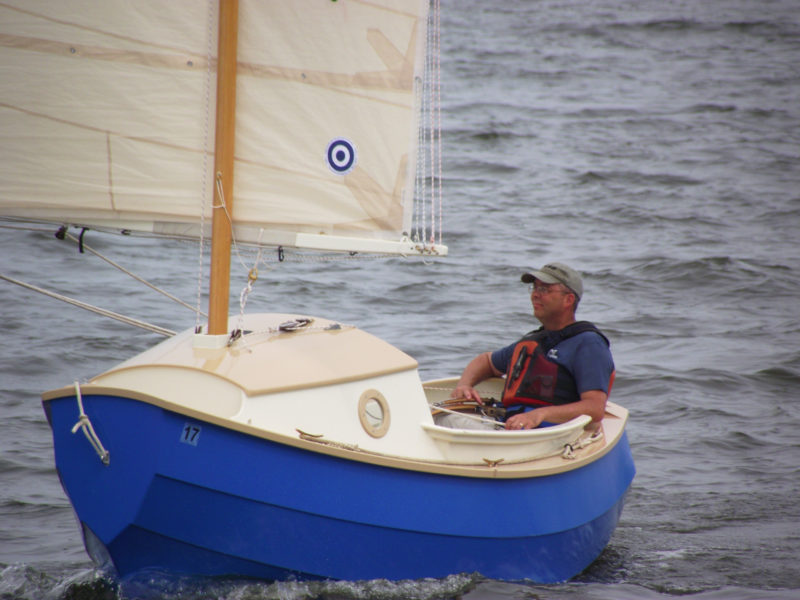
The buoyancy of the blunt pram bow resists digging in while running downwind and reduces the likelihood of broaching.
SCAMP is short, curvy, beamy, and high-sided, with a well-rockered flat bottom and a distinctive pram bow—a cross between a bulldog, a basketball, and an angry rubber duck. It’s also one of the easiest-launching boats I’ve ever encountered. I barely had time to grab my gear before Ender had the boat rigged and ready: mast stepped, sail hoisted, and rudder hung on the transom. He backed the trailer into the water and shoved SCAMP off. Less than 10 minutes from arrival and it was time to sail.
Josh Colvin, who commissioned SCAMP—an acronym for Small Craft Advisor Magazine Project—wasn’t looking for an ultimate adventure boat when he approached New Zealand designer John Welsford (see WB No. 225 for a profile on Welsford and his design work). “My initial goals for the boat were based largely on a 150-mile sail down the Columbia River, from Beacon Rock to Astoria,” Colvin says. “I kept coming across backwaters and shallow estuarine areas and thinking, That’s where I really want to go , but my 16-footer was too deep, wasn’t easy to row, and if I wanted to overnight up among the reeds, wouldn’t dry out level if the tide left. So the idea I eventually took to John Welsford was for the smallest possible boat that would be able to do all of these things, but still be seaworthy enough to cope with something like the middle of the Columbia River on a breezy afternoon.”
Judging by SCAMP’s popularity among amateur builders—roughly 340 kits or plan sets have been sold since 2011, with about 60 boats launched—plenty of other people are interested, too. Designer John Welsford sees SCAMP as a sort of 21st-century version of a much-loved classic, the Mirror dinghy. “While we don’t expect to do anywhere near as many boats,” Welsford says, “it’s hitting a similar, but older market.” Along the way, SCAMP has fostered an enthusiastic and supportive community of builders and owners, encouraging new builders to take the plunge.
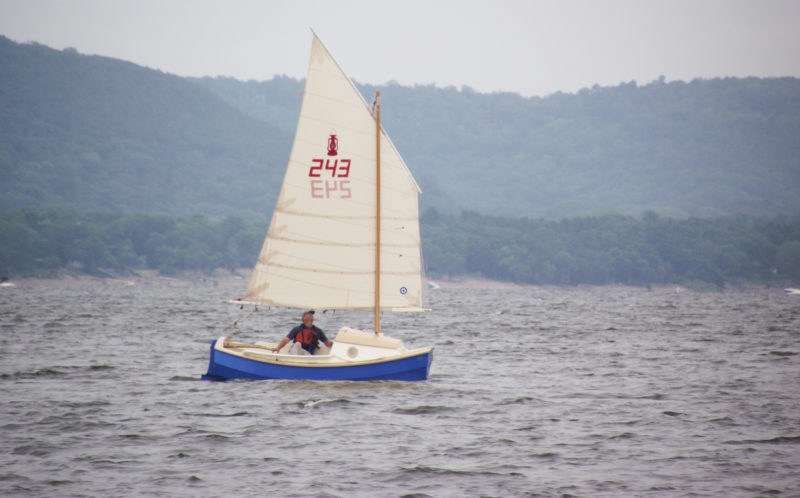
The SCAMPS’s 100-sq-ft sail is set high for good visibility under the boom and is easily reefed.
To bring the new design to life, Welsford was able to make good use of his previous experimentation with similar boats. “SCAMP is number six in a series of very beamy, shallow-bodied boats with that distinctive high-positioned pram bow,” Welsford says. “Tender Behind, Tread Lightly, and Sherpa are the other designs that made it to plans. All work really well, can carry huge loads for their size, sail well, and are well balanced. I learned something from each of them, and SCAMP is a result of that learning.” Besides Welsford, boatbuilder/designer Kees Prins of Port Townsend, Brandon Davis of Turnpoint Design , and adventurer/prototype tester Howard Rice all contributed to final design details and kit elements for SCAMP.
SCAMP is built upright on its flat bottom, which serves as the base for an egg-crate arrangement of plywood that forms the boat’s furniture and structural members. No temporary molds or frames are used. It’s a method that makes for an exceptionally stiff hull, and a safe one—the completed “boxes” create six entirely separate buoyancy chambers within the glued-plywood lapstrake hull. Welsford reports that one SCAMP was able to remain comfortably afloat despite suffering “a hole in the side that you could put your head through” after hitting a snag. And although there are plenty of parts to assemble when building a SCAMP, no single step requires more than moderate woodworking skills and a selection of basic tools.
S CAMP is rigged with a single balanced lugsail, an excellent choice for a cruising rig that’s simple to handle and easy to reef. With 100 sq ft of sail and the stability to stand up to it, the boat also performs well. On my second sail in a SCAMP, working to windward on a gusty day, I was able to keep ahead of a 21′ Sea Pearl for several miles. SCAMP’s shallow draft and flat bottom make it a perfect gunkholer, and 173 lbs of water ballast (roughly 40 percent of the total hull weight) make it capable of much more. It’s no pulling boat, but SCAMP won’t be too difficult to move under oars when necessary. Some builders have considered experimenting with a single sculling oar at the transom; Dave Ender plans to try a yuloh. There’s room to mount a small outboard on the transom for backup propulsion.
Builders have the choice of building from plans or from a kit, with custom sails and hardware available for purchase. Another popular option for builders is the SCAMP Camp , a two-week intensive class in which participants come together to assemble their own SCAMP kits under the direction of designer John Welsford and prototype tester Howard Rice.
One unintended feature of the design deserves mention: several SCAMP builders I have met describe the boat as “a chick magnet,” and from my own observations at various messabouts and festivals, I’d say that such a claim is closer to reality than to hype. For potential builders with wives or girlfriends reluctant to take up sailing, this might be the single biggest advantage SCAMP has to offer.
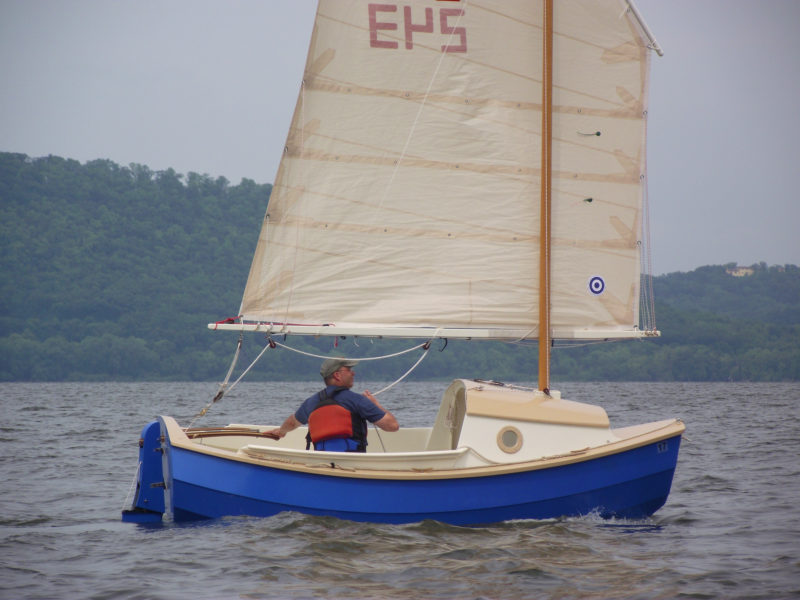
A kick-up rudder allows sailing in shallow water and twin skegs help the SCAMP sit solidly upright when grounded.
B ack aboard Dave Ender’s Scamp, we were away from the dock with an easy shove, heading across Lake Pepin, a wide stretch of the Mississippi that’s often subject to strong winds sweeping down between tall bluffs. Dave filled the ballast tank under the cockpit sole. With the drain holes open, the tank floods itself almost completely; the top of the tank is a few inches above the waterline, so must be topped off by replacing the plugs and pouring water in with a bucket from the cockpit before sealing. He could pour water in quickly without worrying about spilling or overflowing: The excess water drains out of the cockpit’s scuppers. With the water ballast in, we soon shook out the reef we started with, and Dave put me at the tiller. It was a windy day, but even under full sail we continued on in perfect comfort. SCAMP may be a small boat, but it’s the biggest small boat I’ve ever sailed. In fact, it’s almost impossible to categorize SCAMP by size. It weighs just over 400 lbs empty, but has the cockpit and freeboard of a 20′ keelboat (in fact, the freeboard is so high that reboarding the boat without a pre-rigged foot stirrup or rudder step would be problematic). It’s easy to drag up a SCAMP onto a beach for a quick stop ashore, yet filling the ballast tank adds stability well beyond the reach of a typical small boat. The self-draining cockpit sits high enough above the water that you feel like you’re aboard a much bigger boat—yet SCAMP is extremely maneuverable, tacking easily and spinning around within its own length like the smallest dinghy.
While it performs well enough to keep experienced sailors interested—Dave and I kept pace with several much bigger keelboats without much trouble—SCAMP would also be a great boat for beginners to learn on. The balanced lug makes tacking or jibing very simple and stress-free; lazyjacks hold the sail and boom securely in place, making reefing easy once the lines and cleats are set up; the boat is stable and comfortable. And it’s pure fun to sail. The only thing that I needed some time to get used to was being so far from the water compared to the sail-and-oar boats I usually sail. Of course, that higher freeboard and greater volume help make it easy to recover from a capsize (see the video below). By the time Dave and I returned to the dock, I was reminded again of just how much I like this design, and how much it can do.
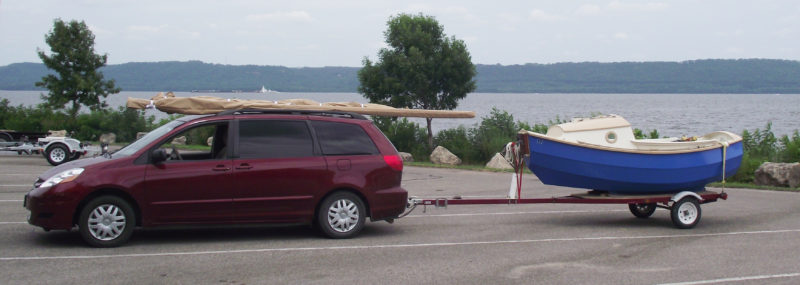
The diminutive SCAMP is easily trailered, rigged, and launched.
With its quick launching capabilities, SCAMP would work well as a family-friendly daysailer. There is space enough for four adults in relative comfort (three is better; two is luxurious), and the boat’s stability makes it a comfortable ride even for the elderly and infirm, young children, or passengers who might simply be a bit nervous around boats. The boom is high overhead, minimizing the risk of hitting an inexperienced passenger, and the seats are wide and comfortable.
Cruising solo or two-up is where SCAMP really shines. The 8′3″ x 29″ cockpit sole provides ample space for one person to sleep aboard very comfortably (the offset centerboard is hidden in the starboard seat face), and filler planks between seats can be used to create a double bunk. The benches themselves (6′8″ by 17.5″) offer a place to stretch out but aren’t quite wide enough for sleeping. There is plenty of stowage space under the seats and cockpit. The “veranda” (a small cuddy/locker at the forward end of the cockpit) provides additional stowage, sitting headroom, and shelter from the wind, as well as a convenient place to anchor the forward edge of a cockpit tent. Forward of the veranda’s bulkhead there are 8.5 cubic feet of sealed stowage that provide extra buoyancy well above the waterline, just where it would be most useful in a knockdown. And of course, like all small boats, a SCAMP can easily travel to windward at 60 mph, pulled on a small lightweight trailer by a small four-cylinder car.
Tom Pamperin ( www.tompamperin.com ) is a frequent contributor to Small Boats Monthly and WoodenBoat.
SCAMP Particulars
LOA/11′11″ Beam/5′4″
Draft (board up)/7″ Weight (including rig)/420 lbs Water ballast/173 lbs
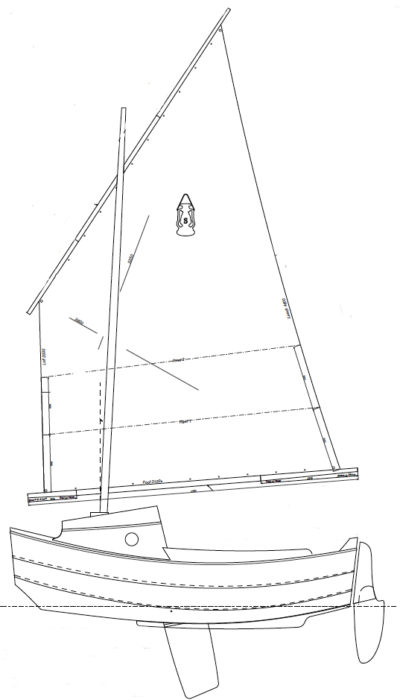
Plans and information are available from Small Craft Advisor . Their YouTube channel has several videos featuring the SCAMP, including a capsize trial with Howard Rice, below.
Is there a boat you’d like to know more about? Have you built one that you think other Small Boats Monthly readers would enjoy? Please email us!
Share this article
Join The Conversation
We welcome your comments about this article. If you’d like to include a photo or a video with your comment, please email the file or link.
Comments (4)
Great article! Thanks. I especially enjoyed the fact that during the capsize test, Howard did not lose his hat! Now that’s a sailor. I’ve always been off put by the punt bow, but seeing the boat in action, I can now appreciate it.
That boat did not want to capsize…
Thanks for the kind words about the article; I enjoyed yet another excuse to go sailing aboard a Scamp. It’s a fun and very very capable little boat, that’s for sure.
These are great wee boats, totally sold on the concept especially the seaworthiness. The only thing I would do differently is wear a safety harness in winds like that in the video! I could quite easily see the boat sailing off while you flounder around in the briny!
Comments are closed.
Stay On Course
More From This Issue
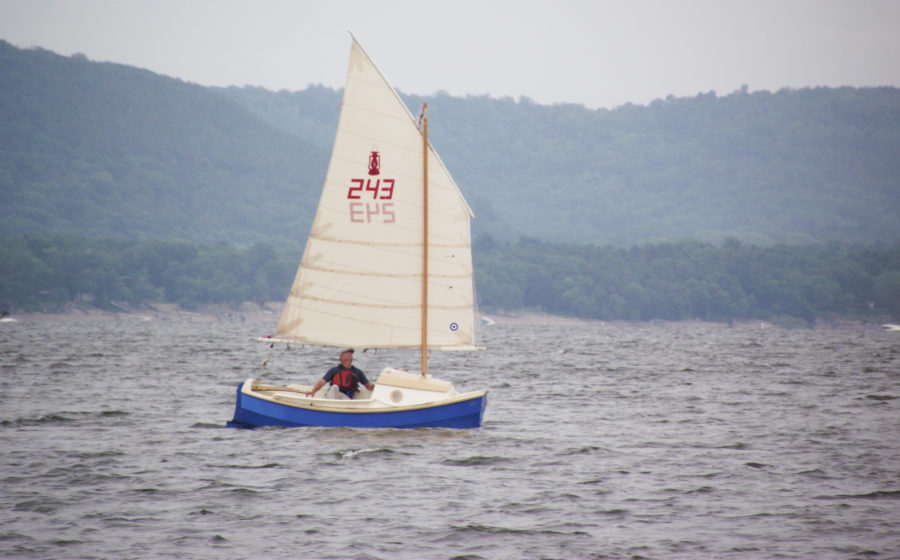
Never mind that until grounding on a mudflat less than 30 miles from the finish line, SCAMP #4 breezed through a difficult year in the 300-mile Everglades Challenge adventure race…
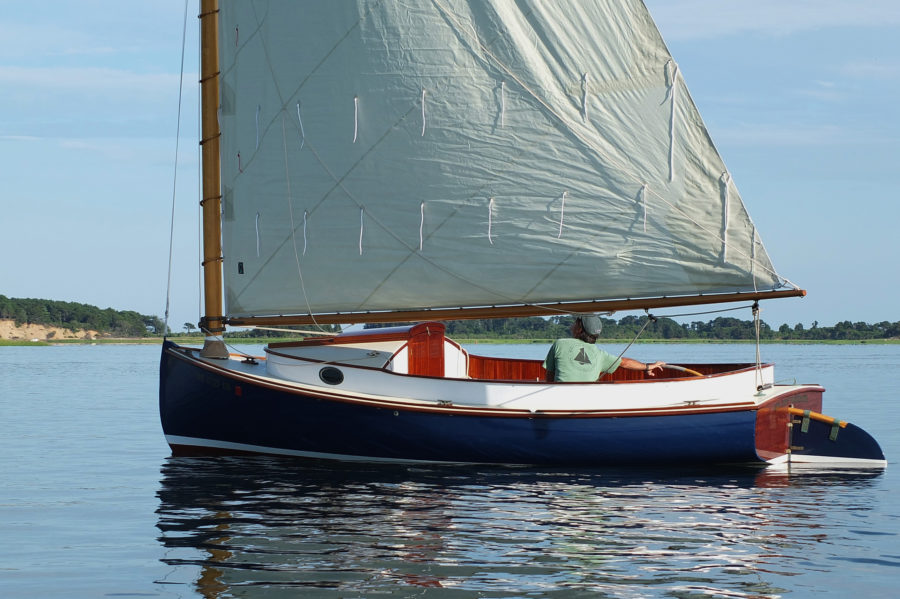
The Caracal
Arey’s Pond is a green, bowl-shaped jewel, one of several ponds in Orleans, Massachusetts, that give access, through narrow, winding waterways, to Little Pleasant Bay and, just to the south,…
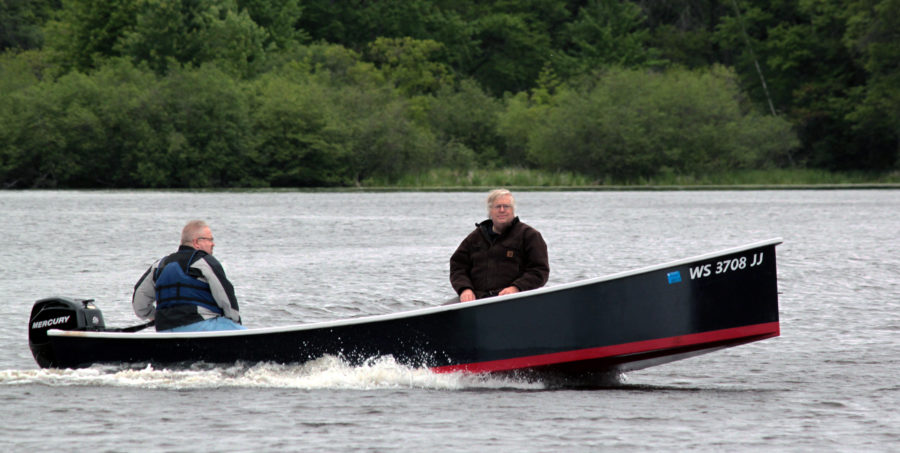
I’ve had a copy of Phil Bolger’s book Boats With An Open Mind for a long time, and I’ve always liked the looks of the Clam Skiff he designed for…
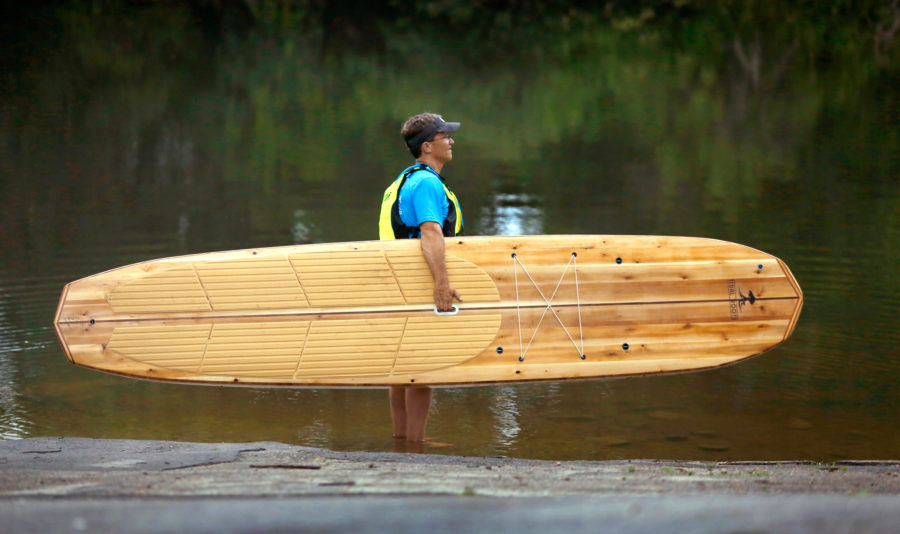
The Sand Bar by Tidal Roots
I was paddling on a placid Royal River with my four-year-old son Noah kneeling in front of me on a wooden Tidal Roots stand-up-paddle (SUP) board. The water hissed quietly…
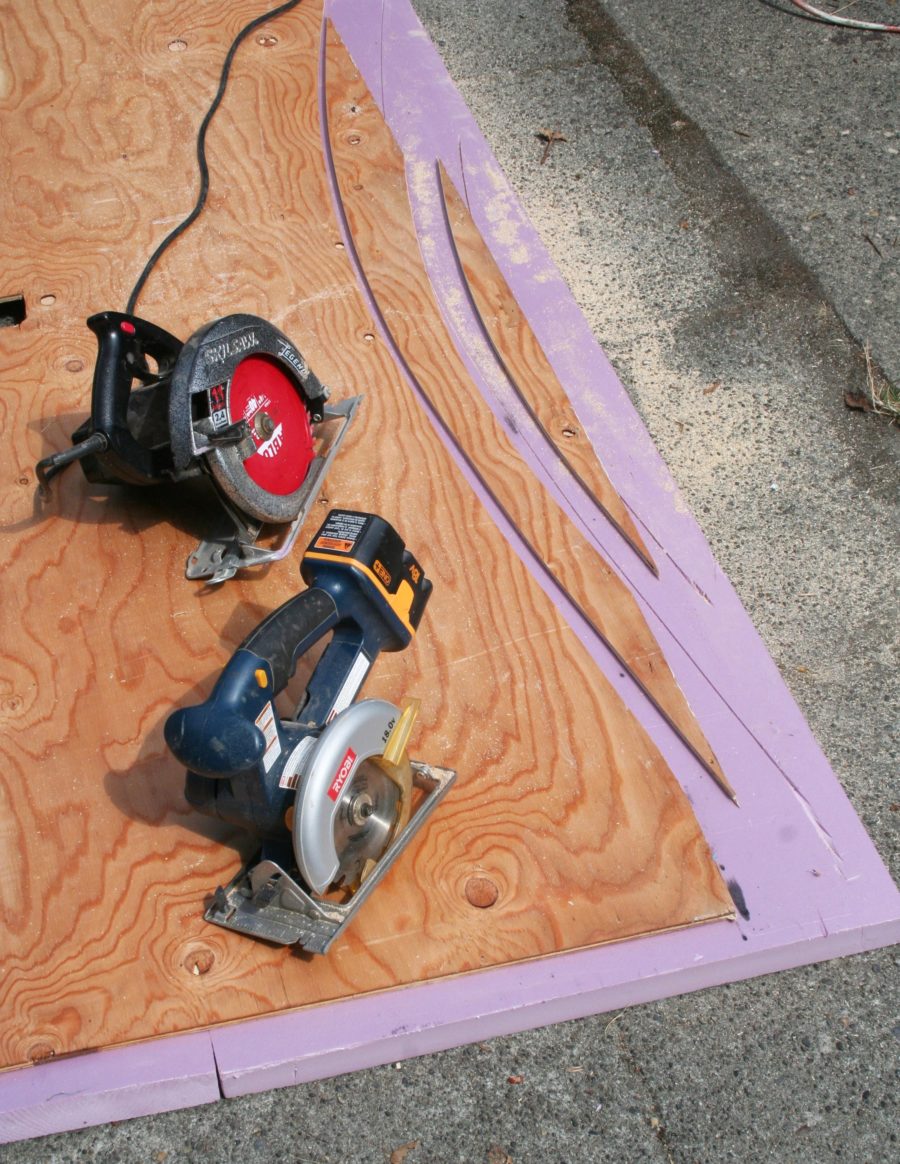
The Taming of the Sheet
Most of us who build boats at home do not have the facilities needed to handle 4′ x 8′ sheets of marine plywood with ease. I’ve always found it challenging…
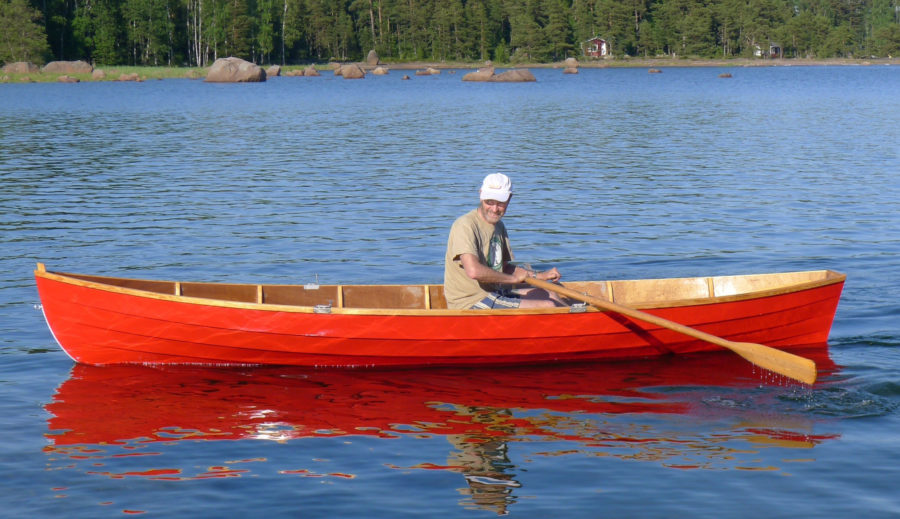
In Finland and much of the eastern Baltic region, networks of interlocking lakes were once the only links between settlements and farms; boats were the only form of transportation. The…
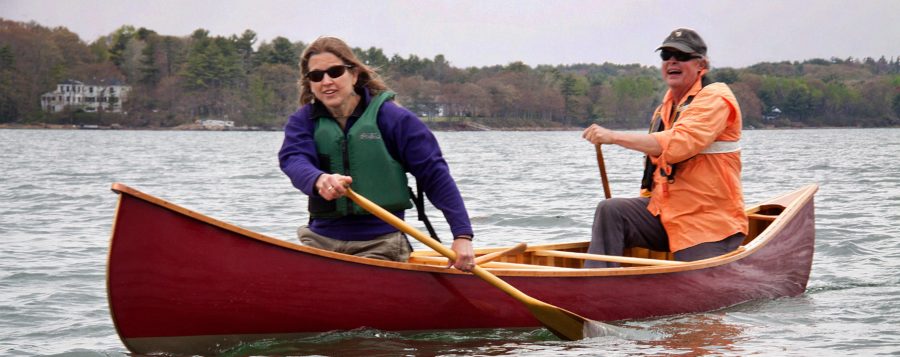
The E.M. White Guide Canoe
Not long after our first wedding anniversary—celebrated with an overnight canoe trip on the Narraguagus River in Maine—Sharon and I acquired our first boat, an 18′ Grumman aluminum canoe, complete…

Made in Vermont
I have always loved wooden boats of all kinds, but especially dories, for their elegant simplicity of design, the way they look upon the water, the way they handle in…
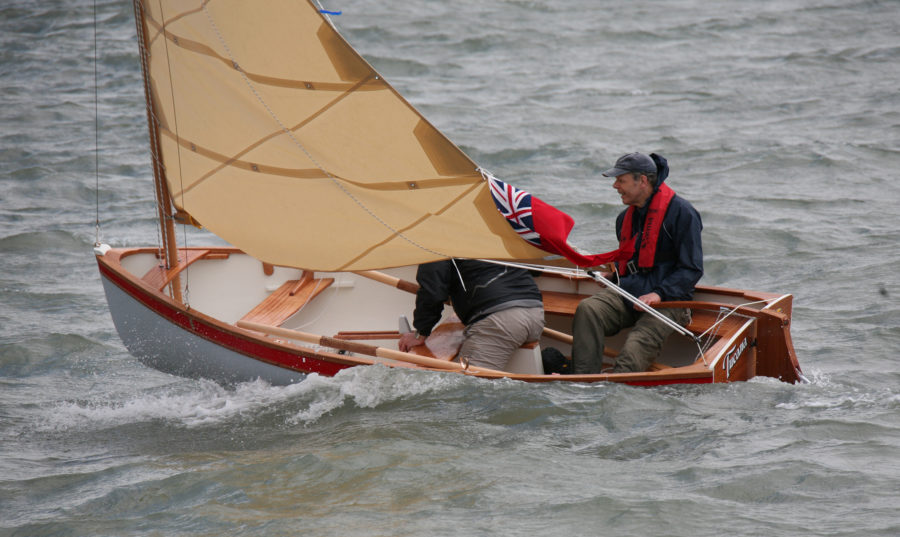

The Mallard
When the now-defunct magazine The Boatman was launched in the early 1990s, one of its objectives was to provide boat plans suitable for amateur construction. One such boat was the…
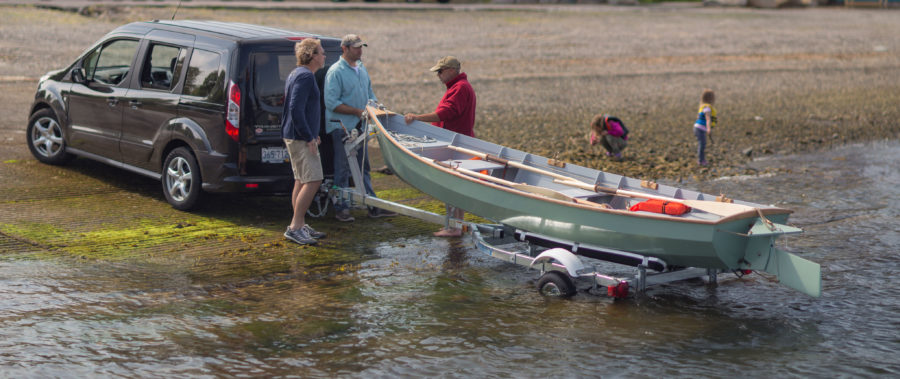
ZO Boats is a new company started by Bill Koffler and Scott O’Connell, partners in Aquidneck Custom Boatbuilding, a company specializing in high-tech composite construction. Involved in modern yacht construction…
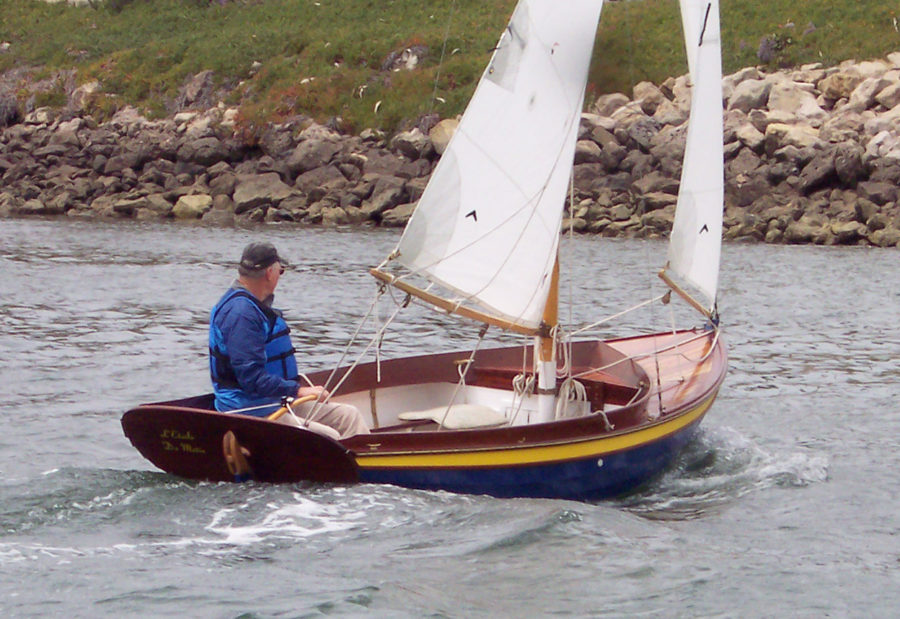
The Somes Sound 12½
A century ago Nathanael Herreshoff designed a 16′ keelboat known widely as the H 12½ after its 12′6″ waterline length. She was intended to handle the steep chop and strong…
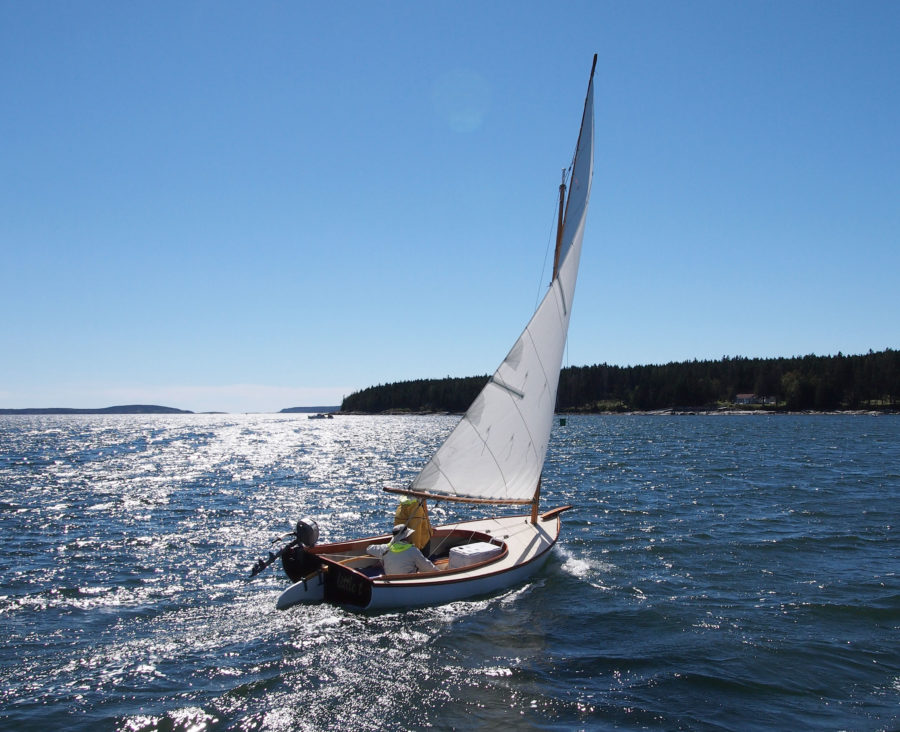
The Marsh Cat
I had spent a long time looking for a boat that I could build to sail the waters of Chesapeake Bay and beyond. The boat would need to be able…
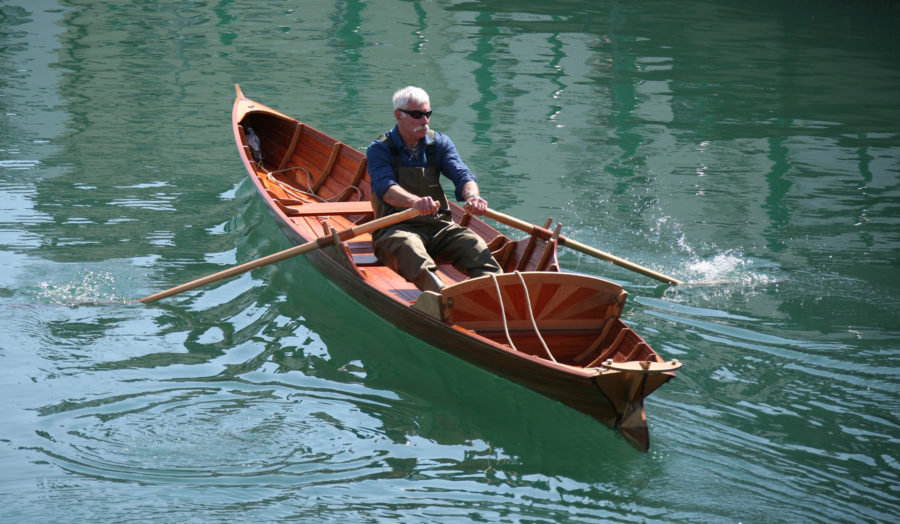
Within the pages of Eric McKee’s Working Boats of Great Britain there are drawings of a 24′ Thames skiff attributed to W.A.B. Hobbs* at Henley-on-Thames in the very early part…
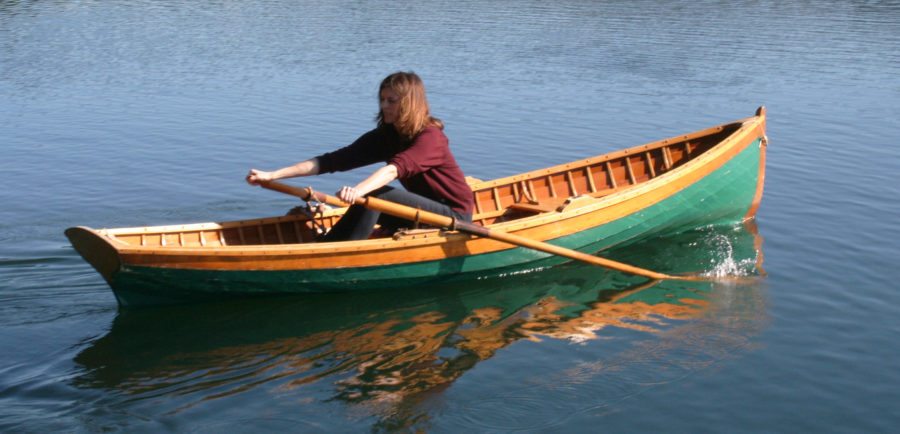
A Lapstrake Livery Boat
What was left of the boat rotting in the brambles on the north shore of Clear Lake in Western Washington was once a very fast boat under oars. Back in…
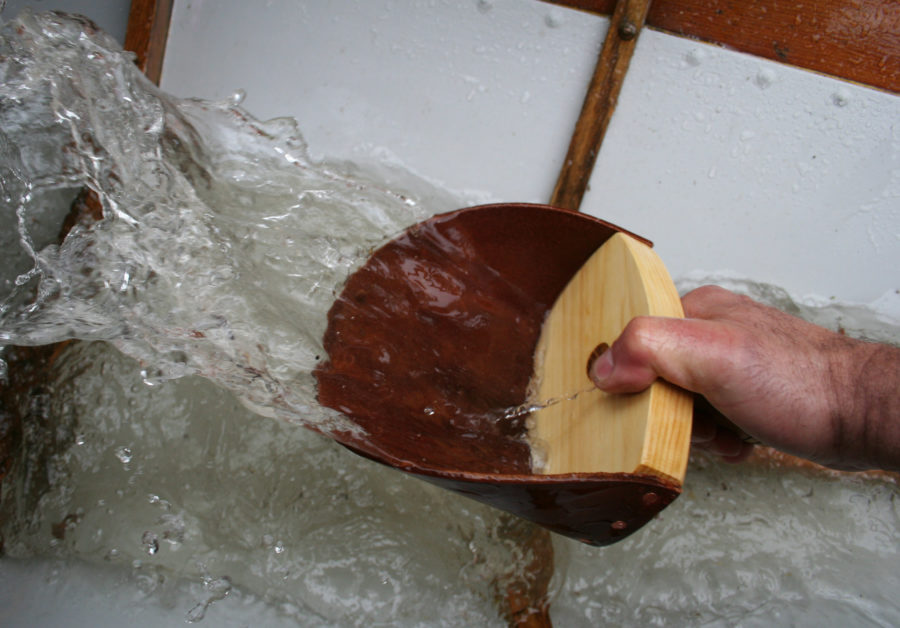
Making a Wood and Leather Scoop Bailer
Once upon a time the boat sharps on the Delaware River were sailing 15 footers with sail areas running to 400 sq ft. No self-bailers, no buoyancy tanks, no crash…
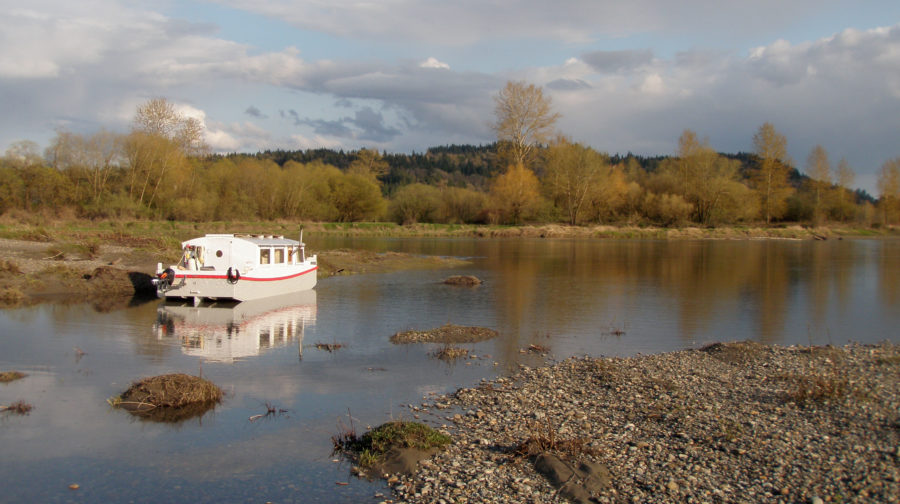
The Escargot canal cruiser
I was sitting in the cabin of the Escargot canal cruiser BONZO, a boat my son, Nate, and his friend Bobby Calnan built the summer after they’d graduated from high…
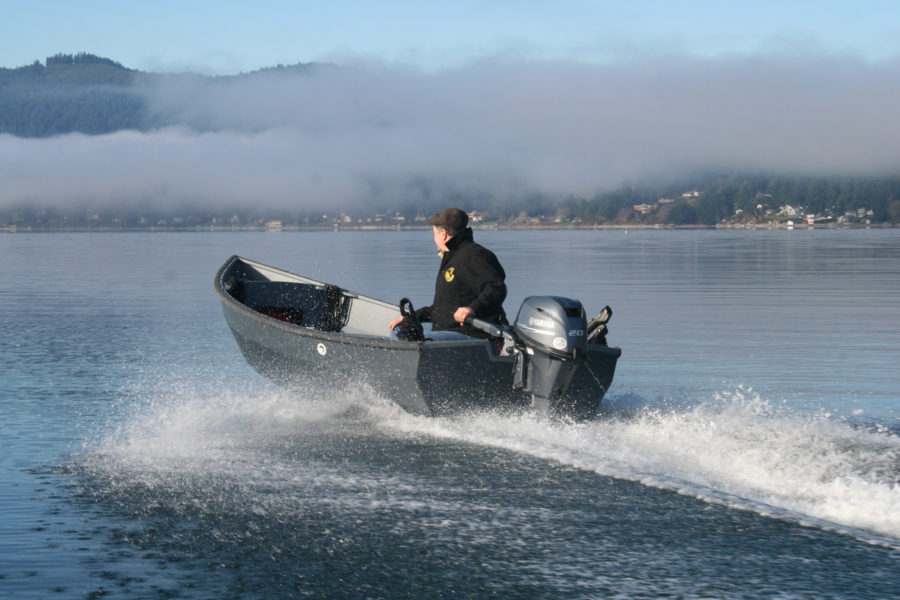
The Candlefish 13
Sam Devlin’s Candlefish 13 began with a client’s detailed request for the design of an outboard skiff suitable for the lakes of Alaska’s Far North. It had to be light…
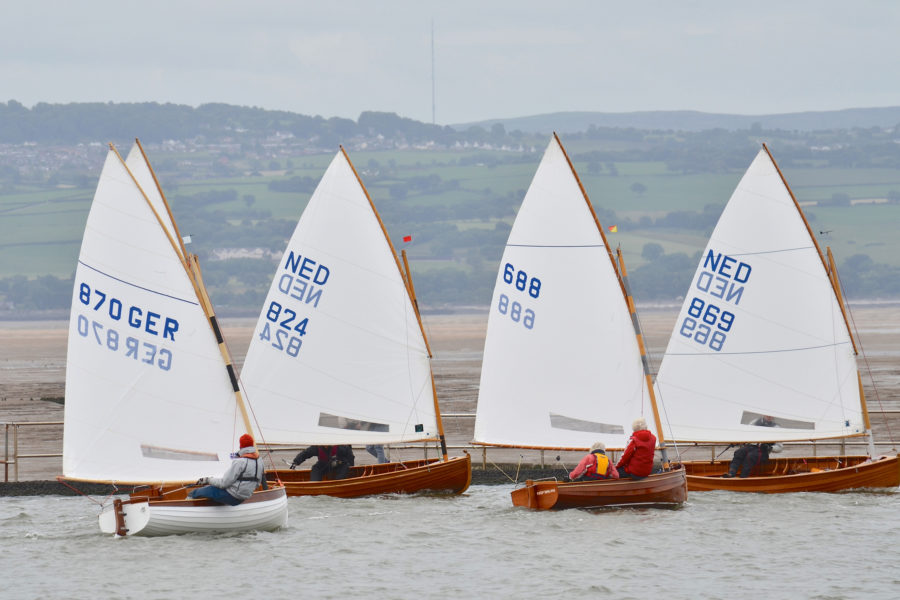
The International 12-Foot Dinghy
In 1913, shortly before the start of WWI, England’s Boat Racing Association (BRA), a small club of sailing enthusiasts, called for a design to comply with the following requirements: length…
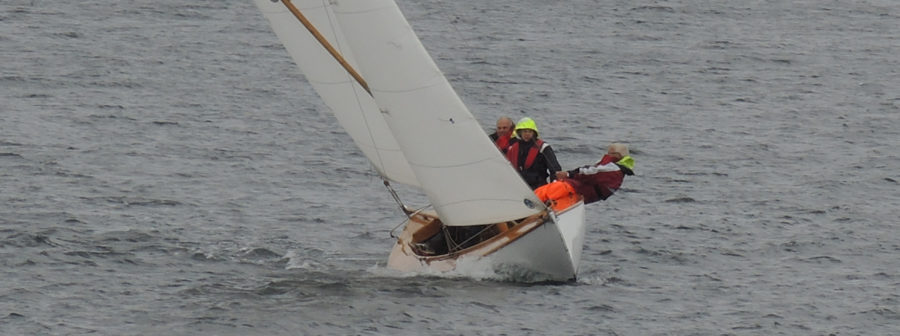
The Færder Snekke
Norway’s Færder snekker constitute a small racing class that hails from outside of Tjøme in the country’s Vestfold region, 55 nautical miles south of Oslo. The two-part name reflects the…
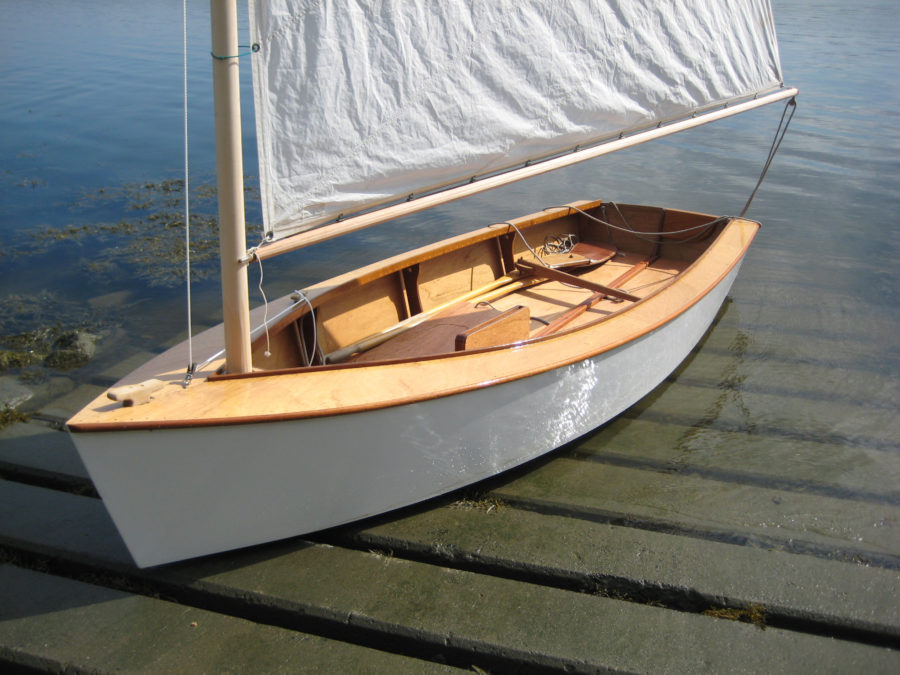
The MerryMac
The MerryMac catboat tends to make the blood hum with a sense of adventure and challenge. Its owners claim that it has always been so since the first of about…
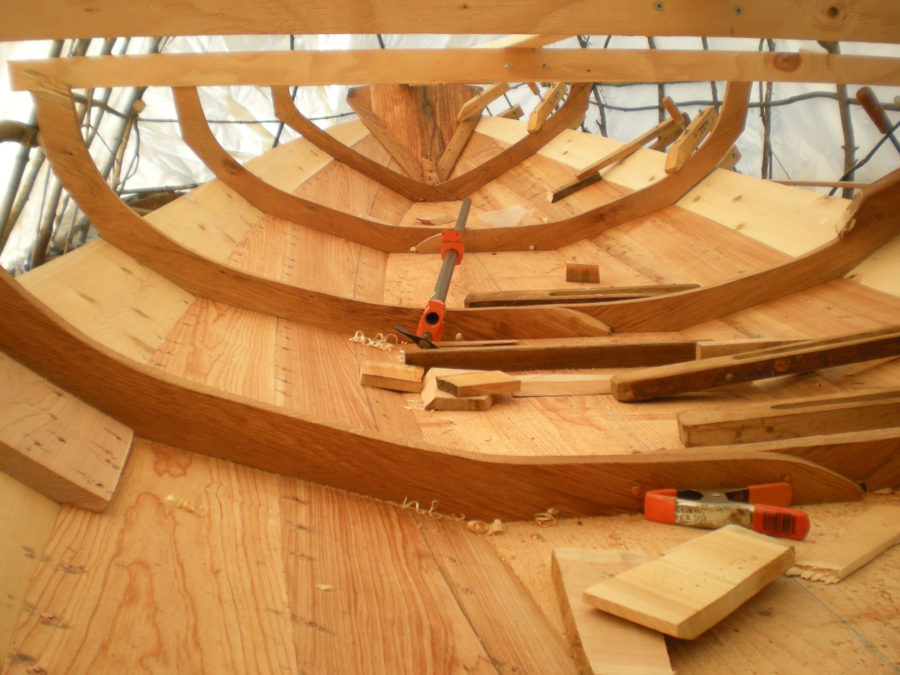
The Mower Dory
One day in the early 1990s, a local contractor visited my boatbuilding shop in Marblehead, Massachusetts, telling me he’d been hired to convert an old boatshop into a playhouse. “The…
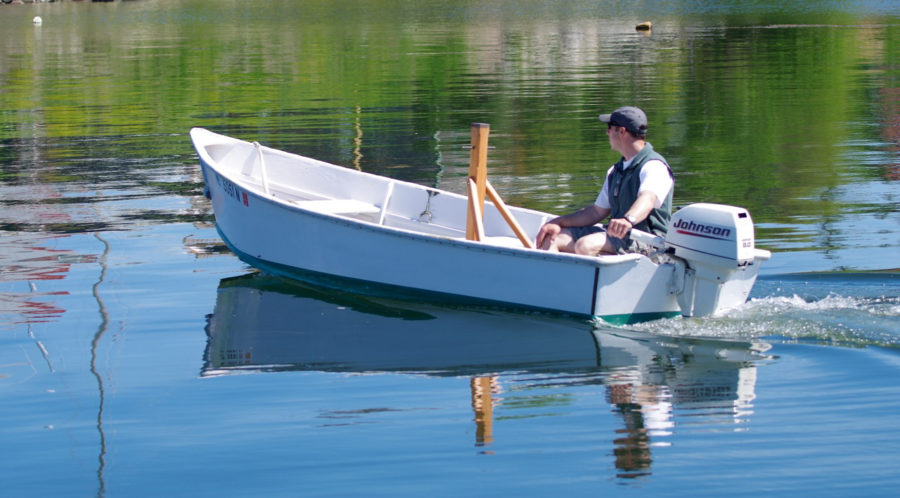
The Willis Boats of Maine’s Dark Harbor
At Dark Harbor, Maine, the legacy of the Rossiter Skiff outshines that of even its most popular fiberglass counterparts. Dark Harbor, located on the mid-coast island of Islesboro, is home…
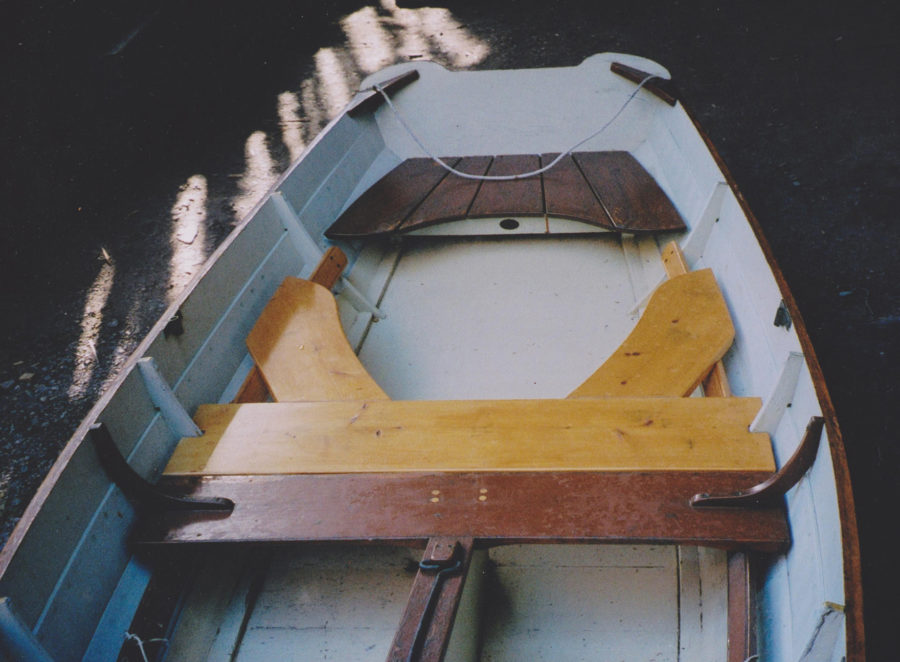
Comfortable Seating for Sailing a Small Rowing-and-Sailing Skiff
As age makes its inevitable changes to the sailor’s once supple joints, certain positions that were once assumed without thought become uncomfortable, if not actually painful. When I was younger…
More Boat Profile
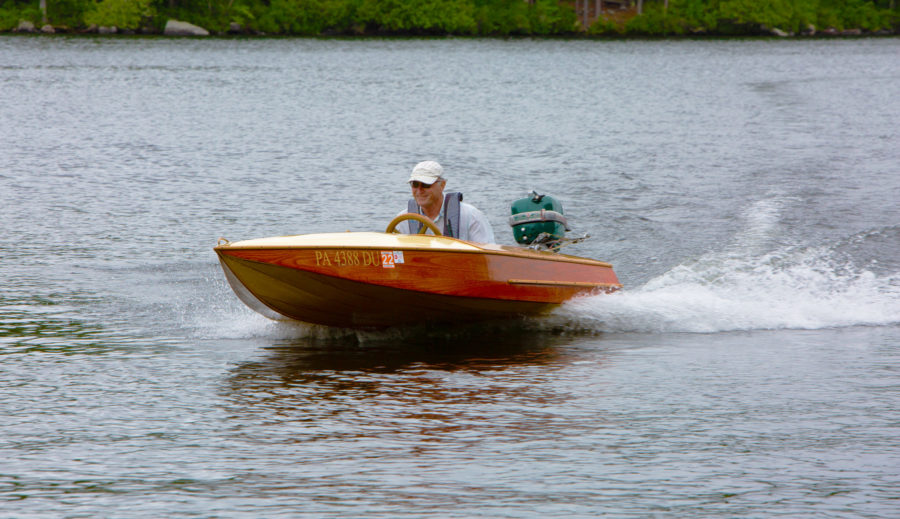
Midget Flyer
When I piloted the Midget, I found that at low speed its trim is close to level; the bow rides up slightly, but not in an unsightly manner. With a…
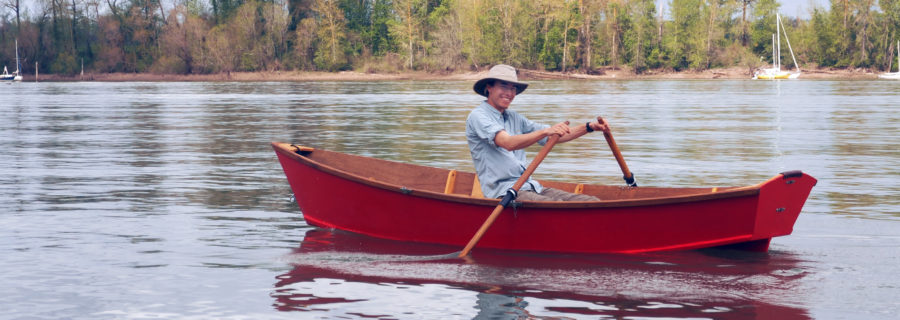
Salt Bay Skiff
Designer Chris Franklin set out with the intention to create a simple, sturdy boat. It was introduced in Getting Started in Boats, Volumes 7 and 8, supplements to issues of…
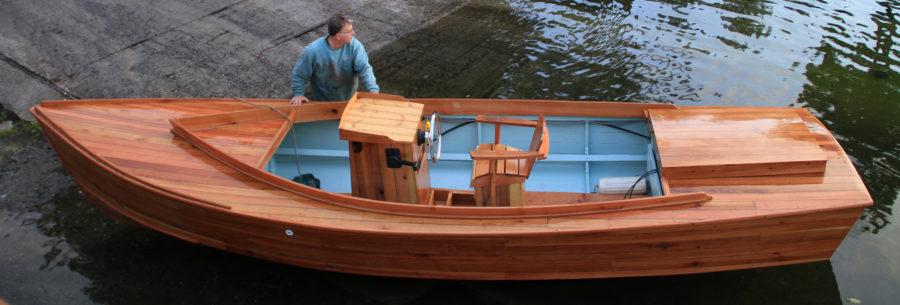
Handy Billy
Harry's website designates this build as best for someone having intermediate skills. It is helpful to have some skills in woodworking (cutting, fitting, and shaping) and problem-solving, but having good…
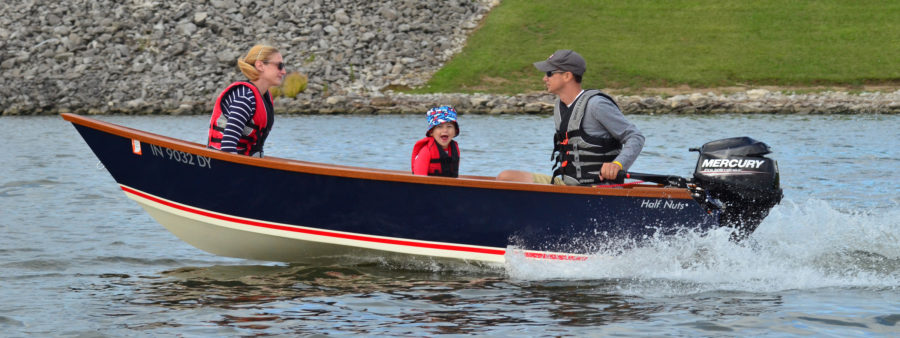
The Tango Skiff has interesting hull extensions that create an attention-grabbing geometry aft of the transom. The additional running surface and buoyancy of the extensions appealed to me because of…
Subscribe Today!
Become a subscriber today and you’ll recieve a new issue every month plus unlimited access to our full archive of backlogged issues.
Already a subscriber? Sign In
Subscribe For Full Access
Flipbooks are available to paid subscribers only. Subscribe now or log in for access.

Call Us: (253) 851-2126 Mon-Fri 9-5 Pacific Time
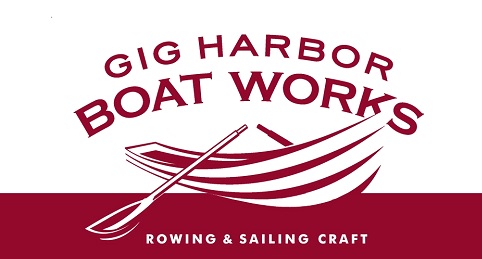
SCAMP Review in Small Craft Advisor Magazine!
by GHBoats Webmaster | Oct 20, 2017 | Press Reviews , SCAMP
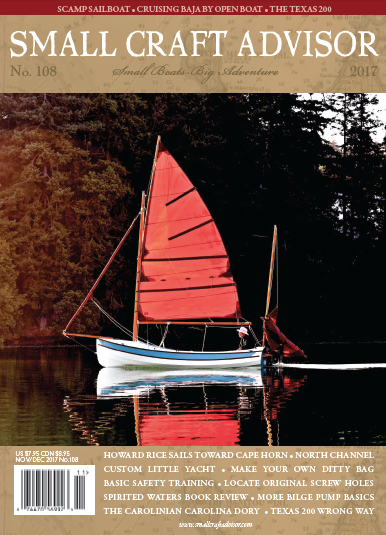
Exciting news that’s been a long time coming . . . the Small Craft Advisor magazine released their first formal review of the SCAMP!
For a bit of backstory, the SCAMP, which stands for S mall C raft A dvisor M agazine P roject, was originally conceived by the magazine as a kit boat that would meet the needs of adventurous small craft sailors. It was designed by a team of passionate and knowledgeable small-craft experts that Small Craft Advisor brought together to build something of the “ideal” capable and fun small craft.
You can see how that history might have made Small Craft Advisor hesitant to review a boat of its own design. As the article says, “Given our involvement with the boat and our predictable biases, we weren’t sure we’d ever publish a formal Review article. However with the passing years and more sailing hours being logged, more owners are available to offer feedback making us confident we can offer a reasonably impartial review of our magazine’s little flagship…”
Our own Falk and Dave were involved in the effort, and we hosted SCAMP events right here in our shop in Gig Harbor as we prepared to adapt the design to fiberglass.

From the archives: The SCAMP rendezvous meeting at the shop
The 6-page review covers the SCAMP as a whole, including both kit-constructed models as well as the fiberglass version made by us here at Gig Harbor Boat Works. It is filled with the personal feedback of both DIY builders and those who’ve purchased our fiberglass boats ready to sail, and it quotes several other press reviews as well.
We’ve republished a few excerpts here – but the whole thing is worth reading. For the full article, please see the check out the Nov/Dec issue of Small Craft Advisor . (Note: the PDF issue is available for purchase here .)
SCAMP Review
This distinctive microcruiser with unusual features has established a cult following.
It all started simply enough. We were on a 150-mile cruise down the Columbia River on our 16-foot sailboat and, even though the boat drew only two feet, we kept coming upon even shallower tributaries and backwaters we longed to explore. The perfect boat for this kind of sailing, we thought, was smaller and simpler, rowable, with a flat bottom and skegs so we could take the ground and wait out the tide if we wanted—a boat that would allow us to explore deeper into the tidal zones and along the water’s edge. To camp comfortably we’d want some accommodations—a good sleeping berth, plenty of stowage, and some protection from the elements—but we didn’t want a fully enclosed cabin, which would be claustrophobic on a boat this size and possibly even dangerous. A partial cabin would be better. We also recognized this was a big river and we saw how rough it could get when the wind blew against the current—this little boat would also have to be seaworthy.
Scamp has been called “sneaky fast,” and compared to a bumblebee for flying better than its shape suggests it should. However you want to say it, Scamp’s performance tends to surprise folks.
. . .
While not a planing boat, Scamp does get up to hull speed quickly and, being generously canvassed, will move in just a whisper of wind. At only 11’11” long it won’t keep up with the fastest 15 to 18-footers, but it will literally sail circles around the slower ones.
Finally, it’s the boat’s extreme maneuverability that might be her best performance feature. With a single sheet and no shrouds or stays, a sailor can put the helm hard over and Scamp will do circles in little more than her hull length, making her quite capable of sailing into marinas or other tight quarters.
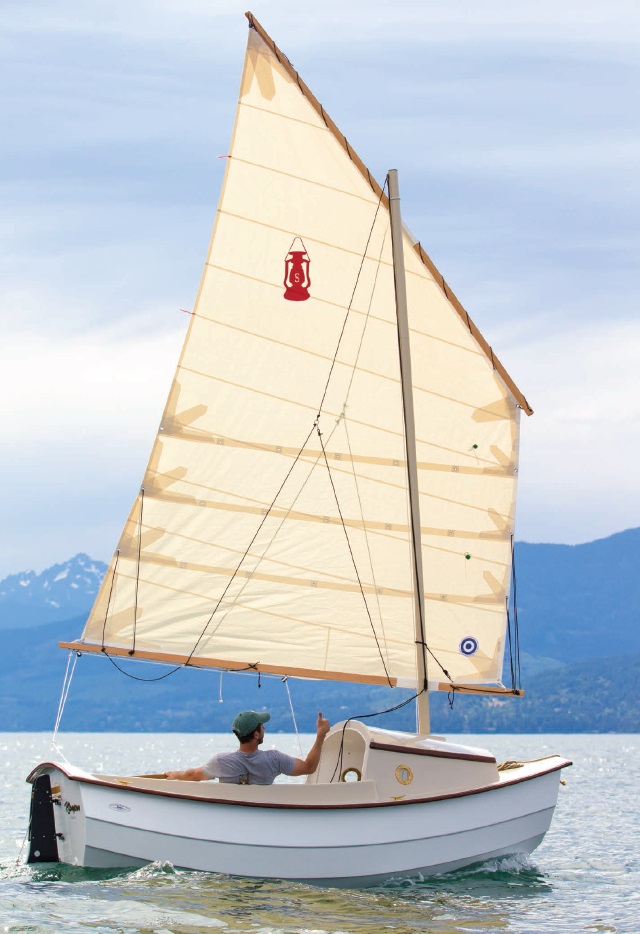
Josh Colvin signals his approval of the prototype Gig Harbor fiberglass Scamp. Photo by Debra Colvin for Small Craft Advisor.
At 420 pounds empty, Scamp is light enough to be trailered by many smaller 4-cylinder vehicles, and an important corollary is that she’s light enough to reposition on her trailer in a garage, or push her bow off the shore when beached.
“Have come to really like the simplicity and ease of sailing with the balanced lug sail.” Todd & Jan Sellick, Litle Bark, GH Scamp.
Where a lot of popular trailerable sailboats are not recoverable after capsize, needing a tow or assistance to right and/or pump out, Scamp was designed with self-rescue in mind. In the event the boat is knocked down she will remain afloat and can usually be righted, re-boarded and sailed away—often without needing much or any bailing.
“Tender to about 10 to 15 degrees then it stiffness up quickly. The boat likes the first reef at 12 to 15 mph winds. The 2nd reef at about 22 mph. Once reefed the boat settles down nicely.” Paul Stovner, Frisky 2015 Gig Harbor Model #367
Few categories are more subjective than sailboat accommodations. Just like with terrestrial camping, where some folks think of backpacks and bivy tents, others imagine motorhomes and microwave ovens. The latter group will find Scamp wanting, but the former will be embarrassed by its excesses.
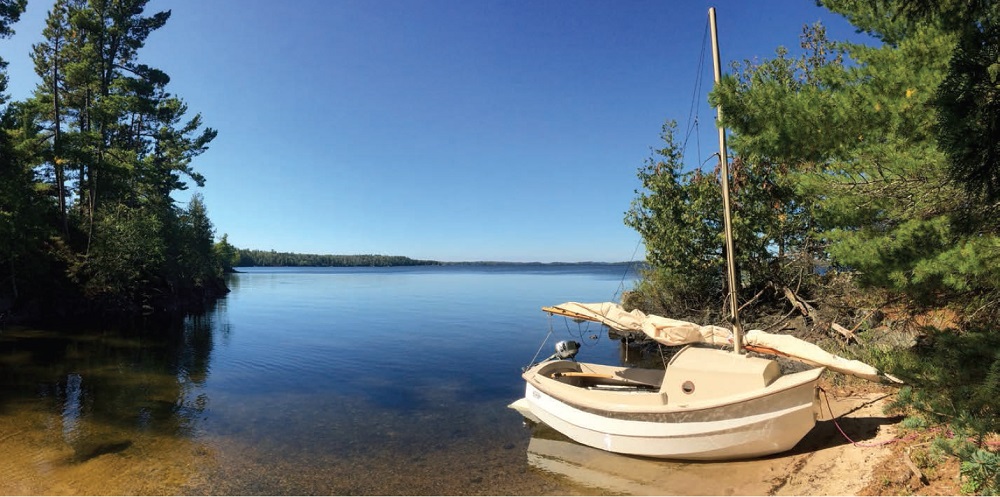
Todd and Jan Sellick’s shot of their ‘glass Scamp Little Bark nosed up to a small island at the east end of Bigstone Bay, on Lake of the Woods, Ontario.
The so-called “glass Scamp” is a perfect match for its wooden sisterships, with no noticeable differences in performance or handling. Certain systems, like the water ballast, lend themselves well to low-maintenance fiberglass construction . Instead of wood, Gig Harbor uses rugged composite materials for things like thwarts and foils.
The Gig Harbor version also employs a two-piece aluminum mast (powder coated in a tan color) that can be broken down for travel stowage. As it’s even lighter than a birdsmouth wooden equivalent, many Scamp builders have opted for the Gig Harbor masts and built their own booms and yards.
“ Very good quality. The boat is two years old and looks new with no gel coat cracks. No issues or failures with the hardware. Very sturdy and ready to take heavy weather. Only flexing is the lower portion backrest coaming in the cockpit. This seems to have no effect on the operation of the boat. No delaminations.” Paul Stovner, Frisky 2015 Gig Harbor Model #367
One question we get now and then is whether someone ought to buy a glass Scamp or build their own. We think the answer is easy: If you’re truly excited about building your own boat and have the time, then go with the kit. If you just like the design and want to go sailing, buy the Gig Harbor model. You’ll probably save money if you build your own, but only if you don’t factor in your time.
“ Very good value, better than a Potter 15 for performance and ease to set up, and more comfortable to sail.” Paul Stovner, Frisky 2015 Gig Harbor Model
Needless to say, SCAMP has surpassed our expectations both as a boat design and in terms of its overall popularity. In addition to proving itself the capable beach-cruiser and backwater explorer we’d imagined, the little boat has inspired adventures, sparked friendships, and drawn new sailors and builders into our small-boat community.
Want to learn more about our fiberglass SCAMP’s creation? Browse through the SCAMP archives!

What’s the first step of building a new fiberglass boat? Building a wood one!
Newest Posts
- Lobster Boat Redesign — Update #2
- Mailbag: Family Diving from a 14′ Whitehall
- New Year, New Digs!
- Save the Date: Seattle Boat Show Feb 2-10, 2024
- Wild Places: Sleeping Aboard the Salish Voyager
- Beach Dolly (1)
- Best of GHBoats (5)
- Customer Questions (8)
- Customization (1)
- Galleries (4)
- Maintenance and Repairs (3)
- Announcements (13)
- Boat Shows (12)
- Just for Fun (17)
- Mailbag (43)
- Newsletters (25)
- Ocean Rowing (13)
- Press Reviews (10)
- Now Hiring (1)
- Woodwork (3)
- Captain's Gig (2)
- Jersey Skiff (4)
- Lobster Boat (4)
- Melonseed (6)
- Navigator (4)
- Nisqually (2)
- Point Defiance (7)
- Salish Voyager (17)
- Swampscott Dory (1)
- Whitehall (6)
- Sea Stories (11)
- Site Guide (4)
- Uncategorized (1)
Blog Archives
Site search.
- Vessel Reviews
- Passenger Vessel World
- Offshore World
- Tug and Salvage World
- Maritime Security World
- Specialised Fields
- Marine Projects World
- Small Craft World
- Tanker World
- Dry Cargo World
- Boxship World
- Aquaculture World
- Trawling World
- Longlining World
- Seining World
- Potting World
- Other Fishing Methods
- Regulation & Enforcement
- Feature Weeks
- Classifieds
- Book Reviews
VESSEL REVIEW | Sinichka – Electric commuter boats designed for Russia’s Moskva River

A series of three new electric monohull commuter ferries have already begun operational sailings on the Moskva River in the Russian capital Moscow.
Built by Russian shipyard Emperium, sister vessels Sinichka , Filka , and Presnya – all named after rivers in Moscow – are being operated by the Moscow Department of Transport and Road Infrastructure Development (Moscow Deptrans). They are the first units of a planned fleet of 20 vessels that will serve the capital city and other nearby communities. The new ferry system will be the water transport system to be operated on the Moskva River in 16 years.
Each vessel has a welded aluminium hull, an LOA of 21 metres, a beam of 6.2 metres, a draught of only 1.4 metres, a displacement of 40 tonnes, and capacity for 80 passengers plus two crewmembers. Seating is available for 42 passengers on each ferry, and the main cabins are also fitted with USB charging ports, wifi connectivity, tables, toilets, and space for bicycles and scooters. The cabin layout can be rearranged to allow the operator to adjust the distances between the seats and to install armrests of varying widths.
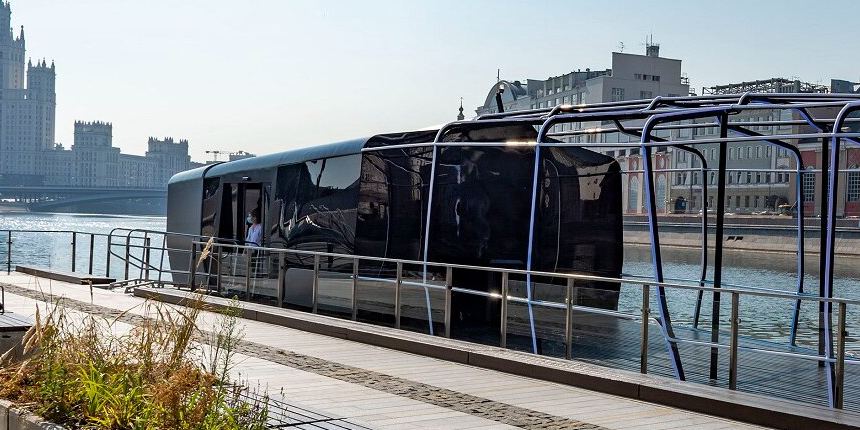
An open upper deck is also accessible to passengers and is the only area on each ferry where smoking is allowed.
The ferries are all of modular construction with each ferry’s wheelhouse, main cabin, and other structural elements being built as complete, separate components. This enables the ferries to be easily dismantled for transport to anywhere in Russia by rail and then quickly re-assembled within seven days.
The ferries are also ice-capable. Recently completed operational trials on the Moskva showed that the vessels can also easily navigate under mild winter conditions with broken surface ice, though year-round operations are planned for the entire fleet.
The ferries are each fitted with 500kWh lithium iron phosphate battery packs that supply power to two 134kW motors. This configuration can deliver a maximum speed of 11.8 knots, a cruising speed of just under 10 knots, and a range of 150 kilometres.
Emperium said the transfer of rotation of electric motors to the propeller is carried out by direct drive. As a propulsion installation, a pulling rotary propeller-steering column with double screws is used. The installation of double pulling screws, with similar power, allows an operator to increase the efficiency of the propulsion system to deliver a slightly higher speed or to reduce energy consumption. This arrangement also provides the ferries with enhanced manoeuvrability necessary for navigating in close quarters.
The batteries themselves have projected service lives of 10 to 12 years and are fitted with safety features such as built-in fire extinguishers and gas vents. Quick-disconnect features allow the batteries to be easily removed for replacement or maintenance.
Some of our readers have expressed disquiet at our publication of reviews and articles describing new vessels from Russia. We at Baird Maritime can understand and sympathise with those views. However, despite the behaviour of the country’s leaders, we believe that the maritime world needs to learn of the latest developments in vessel design and construction there.
Click here to read other news stories, features, opinion articles, and vessel reviews as part of this month’s Passenger Vessel Week.
Related Posts

Baird Maritime
Tags: Emperium Filka Moscow Moscow Department of Transport and Road Infrastructure Development Moskva River Presnya Russia Sinichka WBW newbuild
- Previous VESSEL REVIEW | Ferry Rokko – Second 194m Ro-Pax for Miyazaki Car Ferry
- Next Brighton man to be charged for illegal abalone haul

Baird Maritime , launched in 1978, is one of the world's premier maritime publishing houses.
The company produces the leading maritime new portal BairdMaritime.com , home of the world famous Work Boat World, Fishing Boat World, Ship World, Ausmarine, and Commercial Mariner sub-sites, and the industry-leading ship brokerage platforms WorkBoatWorld.com and ShipWorld.com .
Contact us: [email protected]
© Copyright - Baird Maritime
- Terms & Conditions
- Advertise with Baird Maritime
- Submit News/Leads

Book Your 2024 stay Today!
resort & events center, book our chalet on the hill, year-round, rest. relaxation. renewal., see how your stay supports women in recovery.

Weddings & events

cabins & chalet

cedar river haven
Sign up for updates, news & more, browse our photo album.

- Guided tour
River Cruise on Luxurious Radisson Boat
- Description
- Choose date

Equipped with ice-breaking technology, these huge fancy yachts are the only river cruisers running all year around. The round trip journey takes two and a half hours and floats past all the big sights like the White House, Novodevichy monastery and the Kremlin. There’s a large open air observation deck up top, while the main body of the ship houses a restaurant with a dance floor for a romantic post dinner dance. For a particularly romantic experience take one of the evening boats and admire the bright lights of the city skyline at night.
The most relaxing and picturesque tour that Moscow can offer: a great way to see the city center and its main attractions. This is a perfect alternative to exploring the city by car, if you only have time to do sightseeing during weekday rush hours.
Your English-speaking guide is eager to share every bit of their knowledge about the surrounding landscape, the architecture and historical details.
We conduct Moscow river tour on Radisson Flotilla boats all year around! It’s warm inside during winter months, while there’s air conditioning during hot summer days. You may also treat yourself to drinks, lunch or dinner on board (drinks and food are not included in tour price).
The cost of an excursion with a personal guide for 1 person
Quay at Radisson Collection Hotel
Government Headquarters ("the White House")
Kievsky Railway Central
Novodevichy Convent
Luzhniki Stadium
Academy of Sciences
Monument to Peter I
Cathedral of Christ the Saviour
Moscow Kremlin
St.Basil's Cathedral
Novospassky Monastery
U-turn and back to Quay at Radisson Royal Hotel
Choose your dates
Who's going.
- Excursion River Cruise on Luxurious Radisson Boat
- Date and time:
- Who's going:
See photo of the meeting point

IMAGES
VIDEO
COMMENTS
SCAMP features an offset centerboard, massive flotation from sealed seats and stowage cabin, a water ballast tank holding 173 pounds of water, an after cabin "veranda" that functions like a hard dodger, and a flat bottom and skegs for beaching. PLANS: Complete plans now available on 7 24 x 36" sheets. A complete "Building guide" with suggested ...
The Scamp is a seaworthy 12′ sailboat that can handle a good dose of adventure. Just under 12 feet in length, Scamp boasts an unusual combination of features that give her the unique ability to explore waters too shallow for a larger boat, while retaining most of the bigger boat's comforts and capabilities. An offset centerboard opens up ...
Meet SCALLYWAG, John Welsford's big sister to SCAMP, a 15' 4" x 7' 3" wonder with a "real" cabin, tabernacle mast, mizzen sail, powerful main, water-ballast tanks, sitting headroom down below…and like SCAMP, faster than many onlookers might expect. ... So, following some tweaks by designer and master boatbuilder Kees Prins, the ...
When I posted the photo of the mast location opening, Simeon Baldwin suggested that the sides could be raised by about 3/4 of an inch to allow a sleeve to be installed around the mast and fastened to this extension. This would reduce the amount of rainwater coming in through the mast opening.
Cuddy/cabin. Installing the bow eye. Making the portholes/deadlights. Oar Socket Placement. Making the SCAMP mast. Turning SCAMP over. Sanding, marking waterline and Painting outside of hull. Finishing shaping the Bottom. Making the centreboard.
Spencer gives everyone a run down of the SCAMP him and his buddy, Walter built. 🥬Become a Paid Subscriber and Help Us Out:https://www.thelitzenbergers.com/h...
There will be an ongoing series of "FINISHING SCAMP" video modules available through the SCAMP Channel enabling you to take your boat from the post SCAMP Camp stage all the way to rigging and setting sail. All aspects of the satisfying finish from decking, cabin build, finishing and installing the centerboard ad rudder, mast and spar builds ...
The Scamp is a seaworthy 12' sailboat that can handle a good dose of adventure. Just under 12 feet in length, Scamp boasts an unusual combination of features...
The SCAMP (acronym of Small Craft Advisor Magazine Project) is a wooden or fiberglass hulled Balanced Lug rigged sailing dinghy. The boat is 11 ft 11 in (3.63 m) long, and capable of accommodating four persons on a daysail or one to two for overnighting or extended cruising. Craig Wagner and Josh Colvin, editors of Small Craft Advisor Magazine ...
Official SCAMP Design Logo Burgee. $34.95. Sort by: Show: Our own youthful dreams often featured small boats in starring roles. Aboard these simple, stalwart little vessels we'd venture across nebulous bodies of water in search of distant wild shorelines or uncharted islands. We'd land, hike into the interior, and make camp.
SCAMP has plenty of freeboard, lots of dry stowage, a self draining cockpit-and for safety's sake a huge amount of air-tank buoyancy. ... That little "cabin" is really a secure locker and buoyancy air tank. There is room in there for a sleeping bag, dry clothes, food, matches and such. ... In describing the boat to John we said SCAMP would be ...
SCAMP CNC Building Kit. $3200.00. SKU. SKUskit. We're pleased to offer the highest quality precision CNC kit for the Scamp design. Kit includes all plywood components (planks, bottom, bulkheads, seats, cabin, decks, etc.). Many pieces include notches or scribe lines and numbering to aid construction process.
Jason died when later in life he was sleeping under the Argo and it fell on him. Specifications of the SCAMP that I built: Rig: Balanced Lug Rig (Lugger) LOA: 11 ft 11 in (3.63 m) Beam: 5 ft 4 in (1.63 m) Draft: 7 in (180 mm) with centerboard and rudder up. Hull weight: 420 lb (190 kg) (including rig)
SCAMP. better sea boat. larger more comfortable cockpit. P14/15 provides you with a cabin ... though the cabin is very small and bi-sected by the centerboard trunk and compression post. i found the cabin uncomfortable and last time i tried to get into the cabin of one i wasn't able to do it easily. the P14/15 will turtle and cannot be self ...
Main-1002ft sail with 3 rows of reef points, bag, logo & ties included100 sq ft lugsail made exclusively by Neil Pryde Sails for SCAMP. This class sail is made from 5.5 oz. Challenge Sailcloth in either a classic cream color or Tanbark.
Sunday, June 7, 2015. Launching Day! Scamp #243 is afloat! In the time since my last post I have been busily working away on the boat, and have let the blogging slide. I wanted to be in the water in time for the annual Lake Pepin Messabout, and I'm happy to say I made it!
Josh Colvin, who commissioned SCAMP—an acronym for Small Craft Advisor Magazine Project—wasn't looking for an ultimate adventure boat when he approached New Zealand designer John Welsford (see WB No. 225 for a profile on Welsford and his design work). "My initial goals for the boat were based largely on a 150-mile sail down the Columbia ...
The 6-page review covers the SCAMP as a whole, including both kit-constructed models as well as the fiberglass version made by us here at Gig Harbor Boat Works. It is filled with the personal feedback of both DIY builders and those who've purchased our fiberglass boats ready to sail, and it quotes several other press reviews as well.
The Scamp is a seaworthy 12' sailboat that can handle a good dose of adventure. Just under 12 feet in length, Scamp boasts an unusual combination of features that give her the unique ability to explore waters too shallow for a larger boat, while retaining most of the bigger boat's comforts and capabilities.
The ferries are all of modular construction with each ferry's wheelhouse, main cabin, and other structural elements being built as complete, separate components. This enables the ferries to be easily dismantled for transport to anywhere in Russia by rail and then quickly re-assembled within seven days. The ferries are also ice-capable.
SCAMP Sailboat, Port Townsend, WA. 2,803 likes · 4 talking about this. LOA 11' 11" • Beam 5' 4" • Draft (up) 7" Water ballast 173 lb • Approx weight including rig 420 lbs
© 2024 Cedar River Ranch 2798 Casey Ave Letts, IA 52754 (319)728-3333 [email protected]
Moscow City: View Moscow Beneath Your Feet. $96. Details. River Cruise on Luxurios Radisson Ship with a guided excursion: time to relax and soak in the gorgeous Moscow landscape. Our guide will accompany you and reveal the details behind the structures on the river banks around you.